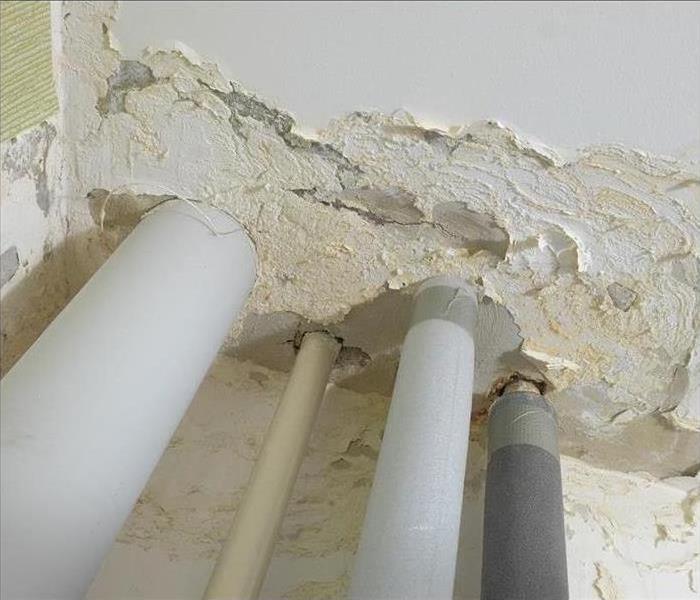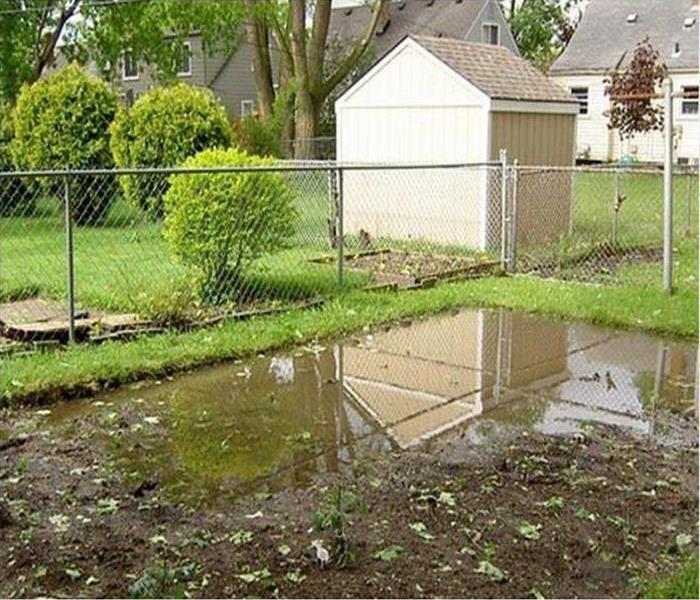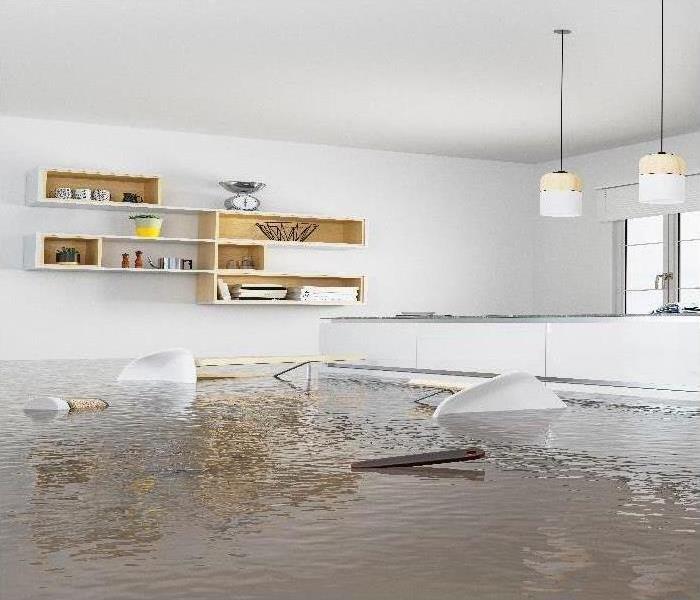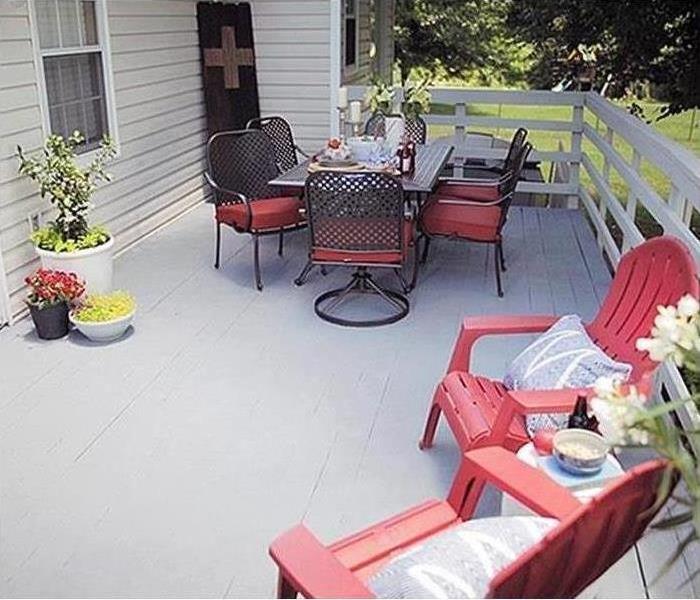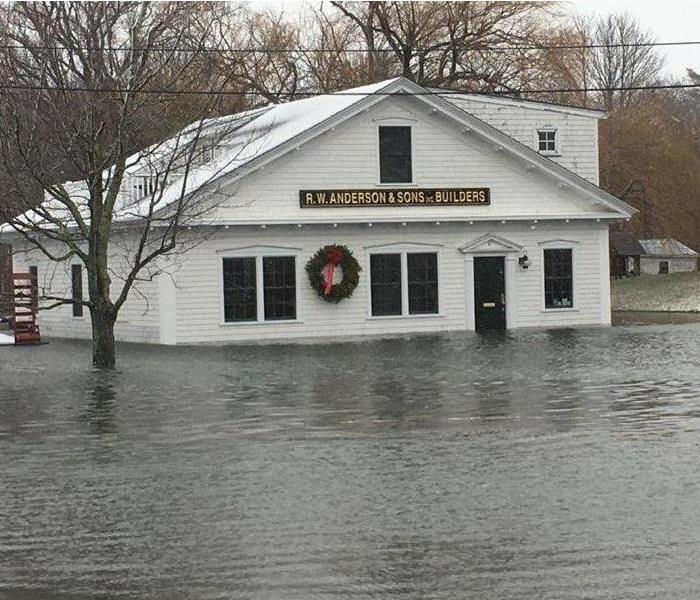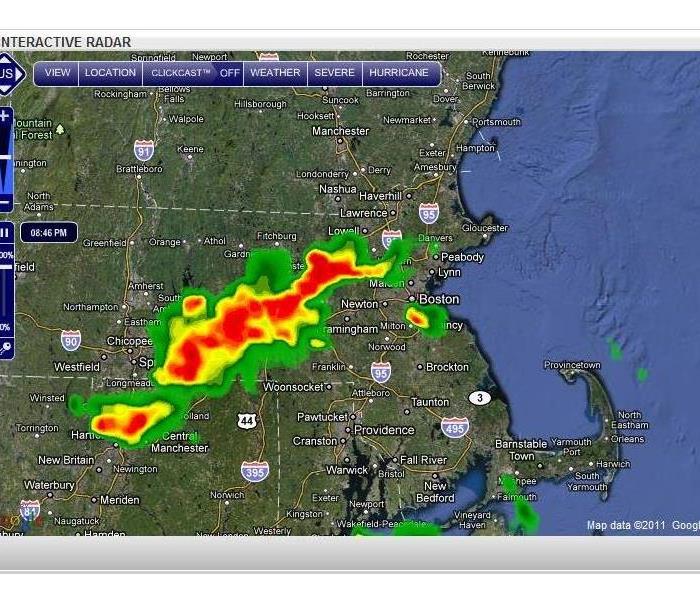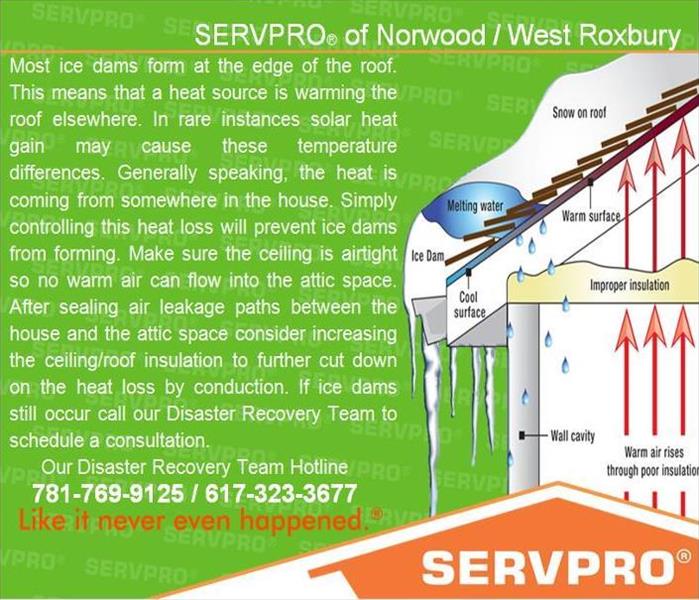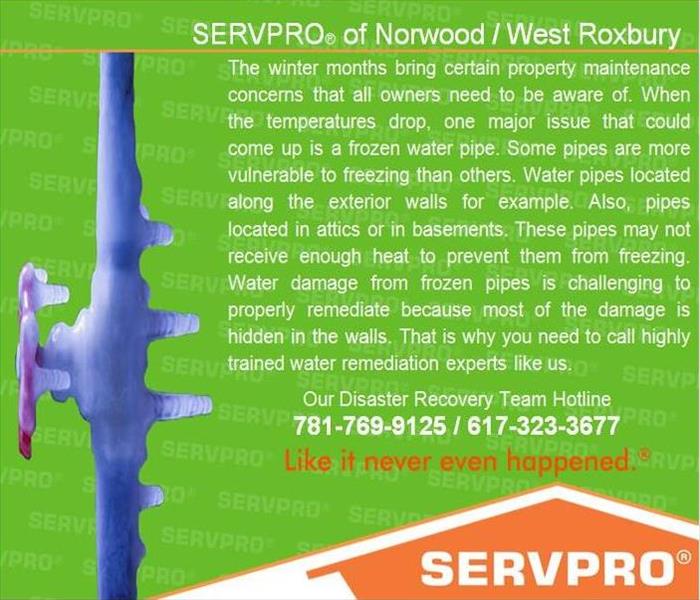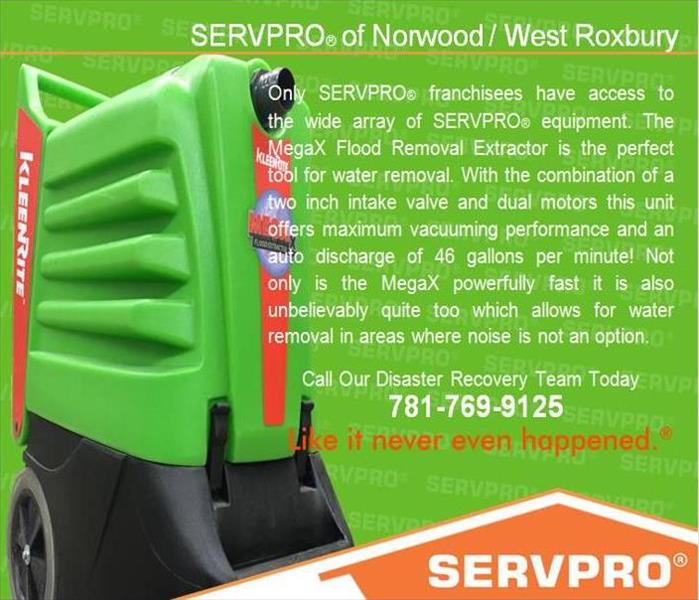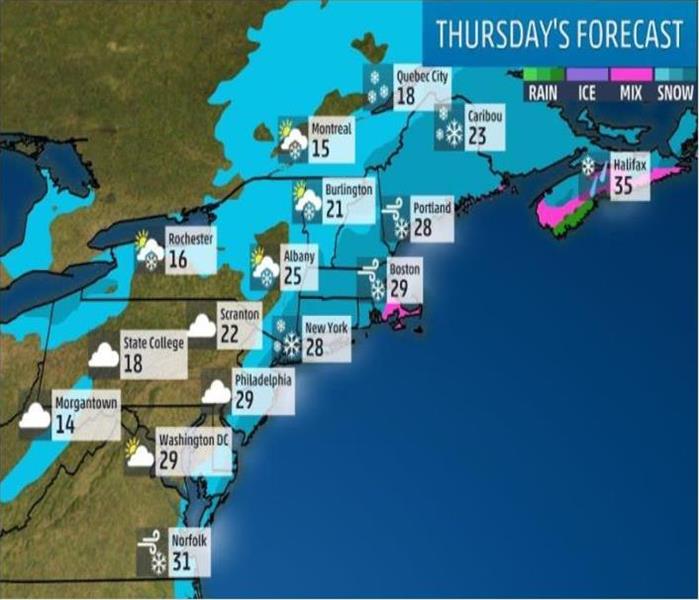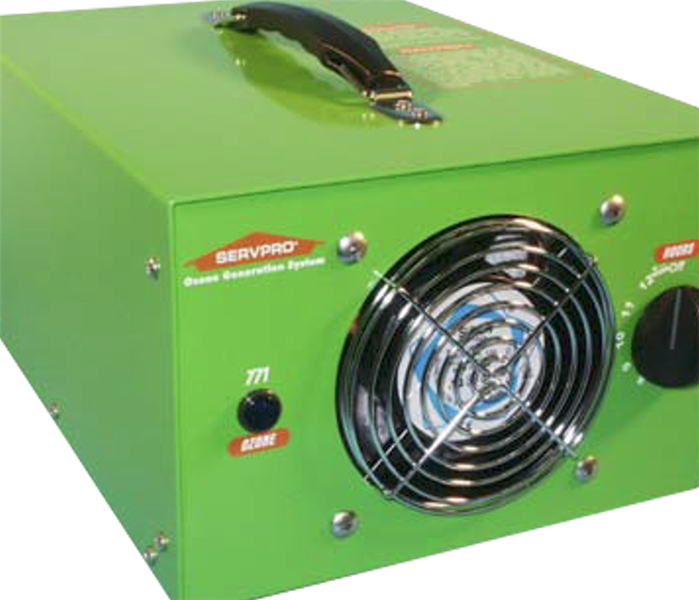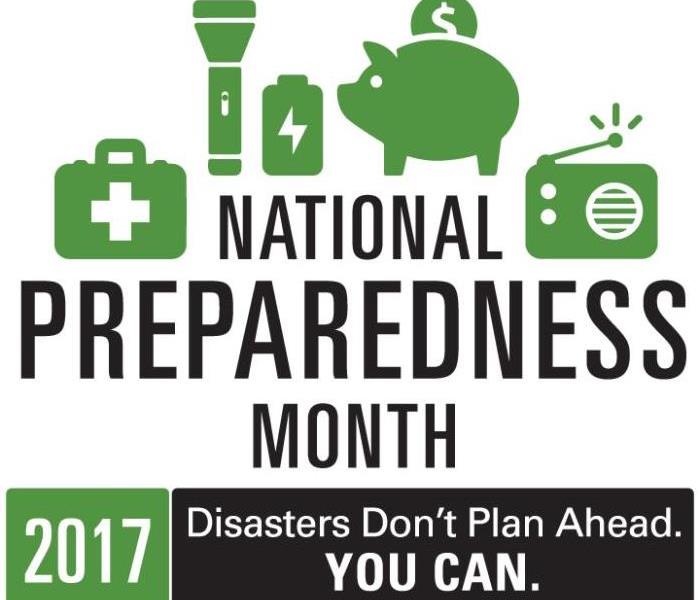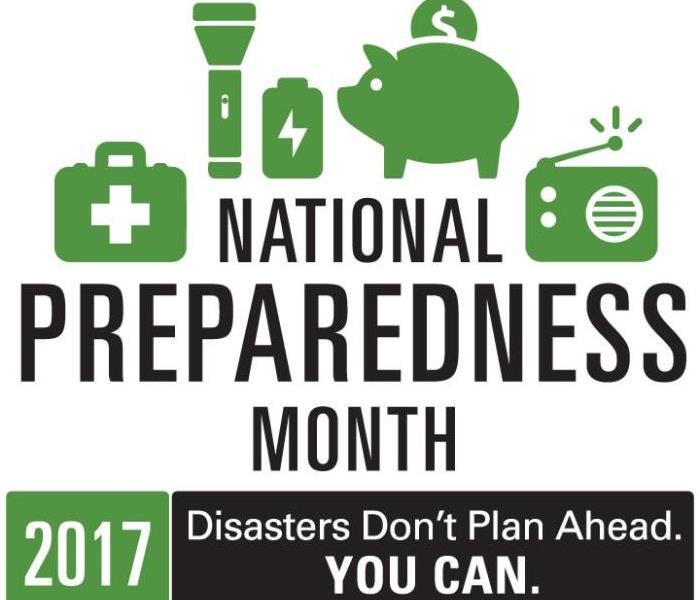Archived Storm Damage Blog Posts
Preparing Your Home or Business for Storm Season
1/21/2025 (Permalink)
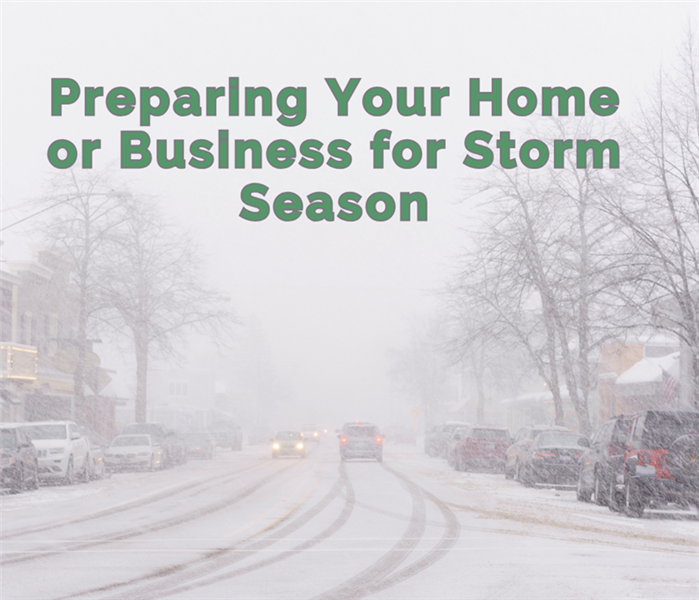 When storms strike, you can rely on us to help you recover and restore your property with professionalism and care.
When storms strike, you can rely on us to help you recover and restore your property with professionalism and care.
Storm season can bring unexpected challenges, but with the right preparation, you can protect your property and reduce potential damage.
Steps to Fortify Your Property
Seal Windows and Doors
Inspect for gaps and use weatherproofing materials to prevent water intrusion.
Maintain Gutters and Downspouts
Remove debris to ensure proper water flow and reduce the risk of flooding.
Secure Outdoor Items
Bring in or anchor down outdoor furniture, tools, and equipment to prevent them from becoming projectiles during high winds.
The Importance of an Emergency Plan
Being prepared with a solid emergency plan is essential for safety and quick recovery. Be sure to include:
Emergency Contacts
Keep important numbers handy, including SERVPRO’s, for fast restoration services.
Evacuation Routes and Safe Shelter
Identify safe spaces and the best paths to reach them during a storm.
Essential Documents and Valuables
Protect important paperwork and valuables by storing them in waterproof containers.
From severe flooding to wind damage, we specializes in restoring properties after storms. Our services include:
Rapid Response
Quick action minimizes downtime and limits further damage.
Expert Training and Advanced Equipment
SERVPRO of Norwood/West Roxbury is equipped to restore your home or business efficiently and effectively.
When storms strike, you can rely on us to help you recover and restore your property with professionalism and care. Stay prepared and stay safe!
Emergency Response for Storm-Damaged Businesses: What to Expect from a Professional Restoration Team
10/24/2024 (Permalink)
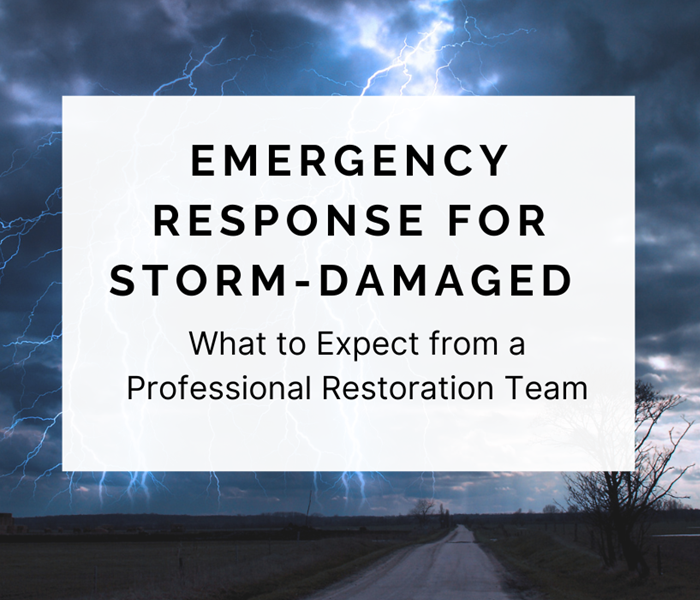 Here’s a breakdown of why working with a professional restoration company is beneficial and what you can expect in the initial stages of storm damage
Here’s a breakdown of why working with a professional restoration company is beneficial and what you can expect in the initial stages of storm damage
Storms can wreak havoc on commercial properties, leaving extensive damage that disrupts operations and jeopardizes safety. Whether it's flooding from heavy rain, roof damage from high winds, or structural issues from ice and snow, the aftermath of a storm can feel overwhelming. For business owners, hiring a professional restoration team is the key to minimizing downtime and restoring normalcy quickly. Here’s a breakdown of why working with a professional restoration company is beneficial and what you can expect in the initial stages of storm damage recovery.
The Benefits of Hiring a Professional Restoration Team
When storm damage strikes, time is critical. Handling the restoration process in-house or delaying a response can lead to further damage and increased repair costs. Here's why hiring a professional restoration company is the smartest choice for your business:
1. Rapid Response and Assessment
Professional restoration companies recognize the urgency of storm damage and typically offer 24/7 emergency services. They respond quickly, assess the damage, and create a customized plan. This rapid response helps prevent secondary damage, such as mold growth, structural issues, or electrical hazards.
2. Expertise and Specialized Equipment
Trained professionals can manage all types of storm damage, from water extraction and drying to structural repairs and decontamination. They use specialized equipment like industrial dehumidifiers, moisture meters, and HEPA vacuums to restore your property thoroughly.
3. Insurance Assistance
The insurance claims process can be overwhelming, especially while managing business interruptions. Restoration companies often work directly with insurance adjusters, helping document damage and ensuring you maximize your coverage. Their expertise streamlines the claims process, reducing your stress.
4. Prevention of Future Problems
Restoration companies don’t just focus on the visible damage. They look for hidden issues, such as water trapped in walls or flooring that could cause mold growth or structural damage in the future. Addressing these potential problems early on can save you from costly repairs down the line.
What to Expect During the Initial Stages of Storm Damage Recovery
Once you've contacted a professional restoration team, here's what you can expect in the first phases of the recovery process:
1. Initial Inspection and Damage Assessment
The restoration team will conduct a comprehensive inspection of your property to determine the full extent of the damage. This involves assessing structural damage, water intrusion, electrical systems, HVAC units, and any other impacted areas. The inspection guides the development of a detailed restoration plan, complete with time and cost estimates.
2. Safety Measures and Immediate Mitigation
In the immediate aftermath of storm damage, safety is a top priority. The restoration team will secure the property by boarding up broken windows, covering damaged roofs with tarps, and shutting off utilities if they pose a danger. If there’s flooding, they’ll begin water extraction and drying right away to prevent further damage or mold growth.
3. Water Removal and Drying
For water damage, high-powered pumps and vacuums are used to remove standing water. Then, industrial-grade dehumidifiers and air movers are deployed to dry affected areas thoroughly. This step is essential to preventing mold, mildew, and long-term structural damage.
4. Debris Cleanup and Removal
Storms often leave behind a significant amount of debris, such as broken glass, fallen trees, and damaged building materials. The restoration team will clear away hazardous debris, creating a safer environment and ensuring the recovery process moves forward without obstacles.
5. Structural Repairs and Reconstruction
After securing the property and removing immediate hazards, the team will start repairing and reconstructing damaged parts of your building. This could involve anything from minor repairs, such as fixing windows or drywall, to full-scale reconstruction of roofs, walls, and electrical systems, depending on the severity of the damage.
6. Monitoring and Moisture Control
Even after visible water is removed, moisture can linger in walls, floors, and ceilings. Restoration teams will continue monitoring moisture levels to ensure the property is completely dry, preventing future mold growth or rot that could weaken the structure over time.
7. Final Inspection and Completion
Once all repairs are completed, the restoration team will conduct a final inspection to ensure everything is restored to its pre-damage condition and is safe for use. They’ll also walk you through the repairs and provide documentation for your insurance company.
Partnering for Peace of Mind
Dealing with storm damage as a business owner is stressful, but working with the right professional restoration team can make all the difference. Their expertise, quick action, and thorough approach help minimize damage and get your business back on track as soon as possible. Instead of being caught up in the chaos, you can focus on running your business with the peace of mind that the recovery is in good hands.
By choosing a reliable restoration partner, you’re not only protecting your property but also ensuring your business’s long-term resilience. When the next storm comes, you'll be ready.
As a trusted leader in the restoration industry, SERVPRO of Norwood / West Roxbury has the advanced training and equipment to restore your home or business. Give us a call at (781) 769-9125 for immediate assistance.
Ensure Your Coverage Is Adequate for Summer Storms in Walpole, MA
8/29/2024 (Permalink)
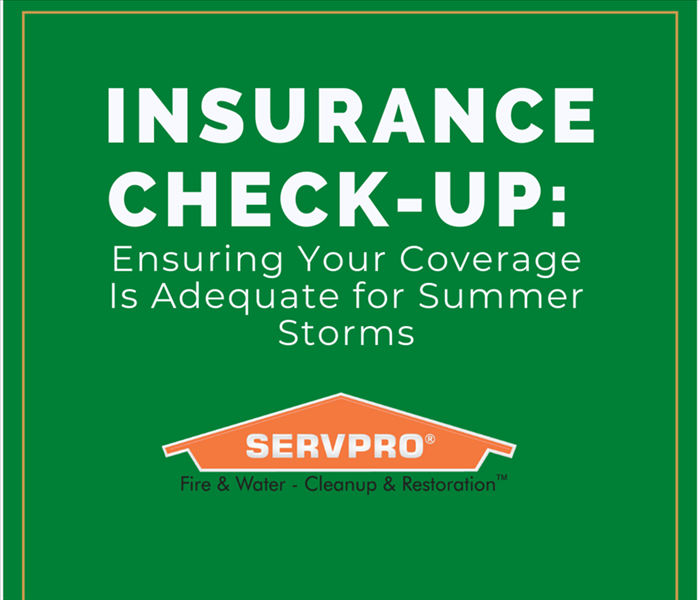 To protect your investment, it’s crucial to ensure your insurance coverage is adequate for these storm-related damages.
To protect your investment, it’s crucial to ensure your insurance coverage is adequate for these storm-related damages.
Summer storms can bring a variety of hazards, including high winds, heavy rainfall, and lightning strikes, all of which can cause significant damage to your home. To protect your investment, it’s crucial to ensure your insurance coverage is adequate for these storm-related damages. Here’s what you need to know about reviewing your insurance policy and preparing for potential claims in Walpole, MA.
Review Your Insurance Policy
Understand Your Coverage: Start by carefully reviewing your homeowners insurance policy to understand what is and isn’t covered. Key areas to focus on include:
- Wind Damage: Ensure your policy covers damage caused by high winds, including damage to your roof, siding, and windows.
- Water Damage: Check if your policy covers water damage from heavy rainfall or flooding. Many standard policies do not cover flood damage, so you may need to purchase a separate flood insurance policy.
- Fire Damage: Verify that your policy includes coverage for fire damage, including fires caused by lightning strikes or downed power lines.
Assess Coverage Limits and Deductibles: Make sure the coverage limits are sufficient to rebuild your home and replace your belongings in case of a total loss. Also, review your deductibles to understand what you’ll need to pay out of pocket before your insurance kicks in.
Consider Additional Coverage: Depending on your location and specific risks, you might need additional coverage, such as:
- Flood Insurance: If you live in a flood-prone area, purchasing flood insurance through the National Flood Insurance Program (NFIP) or a private insurer is essential.
- Windstorm Insurance: In regions prone to hurricanes or severe windstorms, additional windstorm insurance may be necessary.
- Extended Replacement Cost Coverage: This type of coverage can provide extra funds if the cost to rebuild your home exceeds your policy limits due to increased construction costs after a widespread disaster.
Document and Photograph Belongings
Inventory Your Home: Creating a detailed inventory of your possessions is crucial for filing an insurance claim. Here’s how to do it:
- Make a List: Document all valuable items, including electronics, appliances, furniture, clothing, and jewelry. Include descriptions, purchase dates, and estimated values.
- Take Photographs and Videos: Capture clear photos and videos of your belongings. This visual evidence can be invaluable when proving ownership and condition of items.
- Store Documentation Safely: Keep copies of your inventory list, receipts, photographs, and videos in a safe place, such as a cloud storage service or a fireproof safe.
By taking these steps, you can ensure your insurance coverage is adequate to protect your home and belongings from the impacts of summer storms. Regularly reviewing and updating your policy, along with properly documenting your possessions, will provide peace of mind and financial security in the event of storm-related damage.
SERVPRO of Norwood/West Roxbury is your comprehensive solution for residential and commercial restoration and cleaning services. Our highly trained technicians are available 24/7 to address any water, fire, or storm damage in Westwood, MA | Dedham, MA | West Roxbury, MA | Norwood, MA and surrounding areas.
Preparing Your Home for Summer Storms. Essential Steps to Prevent Damage in Westwood, MA
8/18/2024 (Permalink)
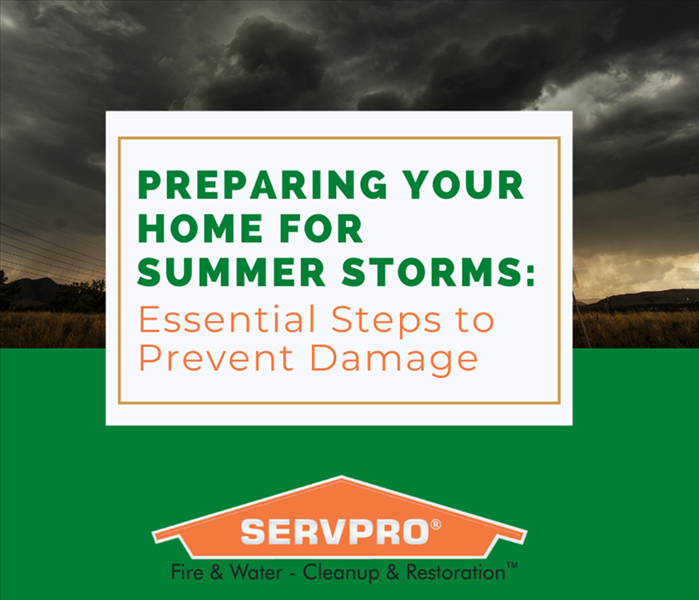 Here are some essential steps to secure your home and minimize storm damage this summer in Westwood, MA
Here are some essential steps to secure your home and minimize storm damage this summer in Westwood, MA
Protecting your home from potential damage requires proactive measures and regular maintenance. Here are some essential steps to secure your home and minimize storm damage this summer in Westwood, MA
Secure Outdoor Furniture
One of the easiest ways to prevent storm damage is to secure or store outdoor furniture and other loose items. High winds can turn patio furniture, grills, and garden decorations into dangerous projectiles. Here’s how to handle outdoor items before a storm hits:
- Bring It Indoors: Move patio furniture, potted plants, and other movable items indoors.
- Secure Larger Items: For larger pieces that can't be moved, use bungee cords or straps to secure them to a stable structure.
- Anchor Down: Consider using anchors or weights for items that are meant to stay outside, like swing sets or heavy garden decor.
Check and Repair Roof and Gutters
Your roof and gutters are your home’s first line of defense against storm damage. Regular maintenance can prevent leaks and water damage. Here’s what to do:
- Inspect Your Roof: Look for loose or missing shingles, cracked tiles, or any signs of wear and tear. Replace any damaged materials promptly.
- Clean the Gutters: Ensure your gutters and downspouts are clear of debris to allow proper water drainage. Clogged gutters can lead to water overflow, damaging your roof and siding.
- Check Flashing: Inspect the flashing around chimneys, vents, and skylights to make sure it’s secure and intact. This prevents water from seeping into your home.
Reinforce Windows and Doors
Windows and doors are vulnerable points during a storm. Reinforcing them can prevent breakage and keep your home safe. Here’s how to fortify these areas:
- Install Storm Shutters: If you live in an area prone to severe storms, consider installing storm shutters. These provide an extra layer of protection against flying debris.
- Use Impact-Resistant Glass: Upgrade to impact-resistant windows and doors. These are designed to withstand strong winds and flying objects.
- Seal Cracks and Gaps: Check for any gaps or cracks around windows and doors and seal them with caulk or weather stripping. This helps keep out water and prevents drafts.
By taking these preventative measures, you can significantly reduce the risk of damage to your home during summer storms. Regular maintenance and timely repairs are key to keeping your property safe and secure. Stay proactive, and your home will be better prepared to weather any storm.
SERVPRO of Norwood/West Roxbury is your comprehensive solution for residential and commercial restoration and cleaning services. Our highly trained technicians are available 24/7 to address any water, fire, or storm damage in Westwood, MA | Dedham, MA | West Roxbury, MA | Norwood, MA and surrounding areas.
Stay Safe When the Winds Roar: A Guide to Tornado Safety
7/9/2024 (Permalink)
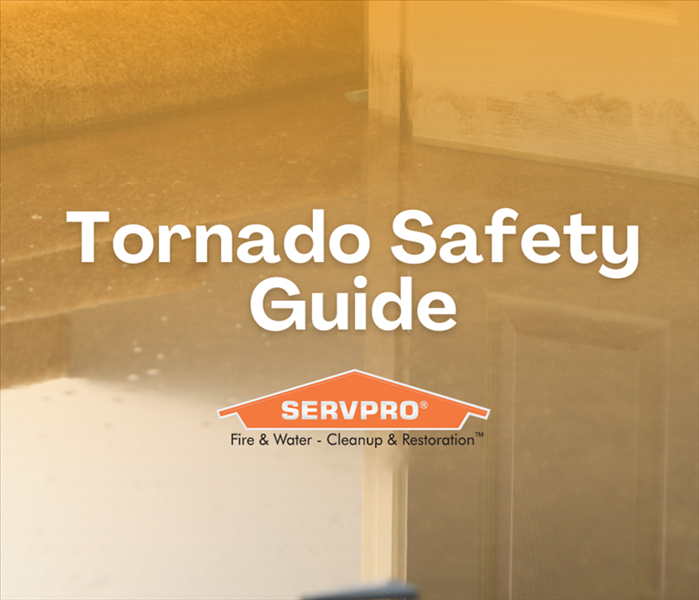 Tornadoes are a serious threat, but with proper preparation and quick action, you can minimize the risks and stay safe during these dangerous storms.
Tornadoes are a serious threat, but with proper preparation and quick action, you can minimize the risks and stay safe during these dangerous storms.
Tornadoes are powerful and unpredictable natural disasters that can cause immense destruction in a matter of minutes. Being prepared and knowing what to do can significantly increase your chances of staying safe during a tornado in Norwood and West Roxbury. Here’s a comprehensive guide to tornado safety:
Understand Tornado Alerts
- Tornado Watch: Conditions are favorable for tornadoes to develop. Be alert and prepared.
- Tornado Warning: A tornado has been sighted or indicated by weather radar. Take immediate shelter if a warning is issued for your area.
Create a Tornado Safety Plan
- Designate a Safe Room: Choose a basement or storm cellar if available. If not, select an interior room on the lowest level of your home, away from windows.
Practice Drills
Conduct tornado drills with your family or household members. Ensure everyone knows the safest place to seek shelter and how to protect themselves.
Stay Informed
Keep a battery-powered weather radio or smartphone with emergency alerts enabled to receive updates on tornado warnings and weather conditions.
Secure Your Property
Remove or secure outdoor items that could become projectiles in high winds, such as patio furniture, grills, and trash cans.
During a Tornado Warning
- Take Shelter Immediately: If you are in a mobile home, evacuate to a sturdy building. If you are outdoors, seek shelter in a sturdy building or lie flat in a low-lying area.
- In a Vehicle: If you are driving and encounter a tornado, do not try to outrun it. Instead, park the car safely, preferably in a garage or shelter. If there is no shelter available, stay in the car with your seatbelt on and cover your head with your hands and a blanket or coat.
After the Tornado
- Wait for Authorities: Wait for authorities to declare the area safe before leaving your shelter. Be cautious of hazards such as downed power lines, gas leaks, and damaged buildings.
- Check on Neighbors: After ensuring your safety, check on neighbors, especially the elderly or those with disabilities, to make sure they are okay and offer assistance if needed.
- Stay Calm: Panicking can impair your ability to make sound decisions. Stay calm and follow your tornado safety plan.
Tornadoes are a serious threat, but with proper preparation and quick action, you can minimize the risks and stay safe during these dangerous storms.
Choose the #1 Experts in Cleanup and Restoration for Residential and Commercial Fire, Mold, Water, and Storm Damage. Contact us today! We can assist with your damage and restoration needs in Norwood and West Roxbury.
Spring Storms Checklist
6/13/2024 (Permalink)
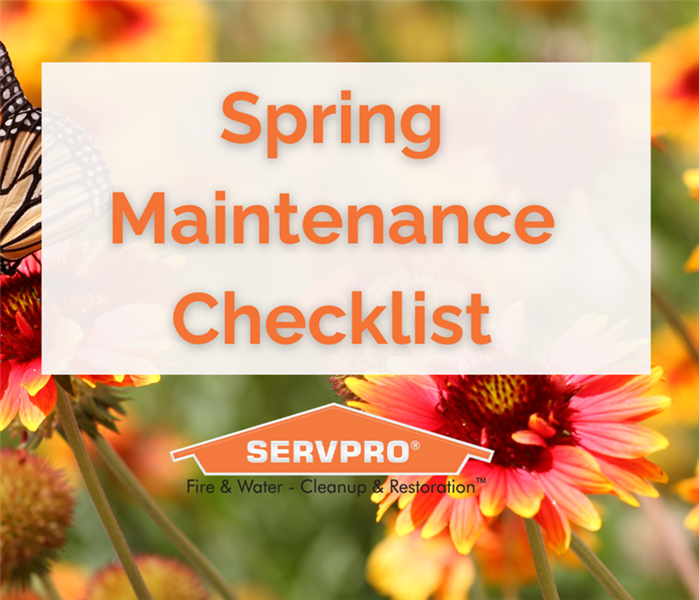 To help you stay ahead of potential issues, we've put together a comprehensive checklist for your spring maintenance routine.
To help you stay ahead of potential issues, we've put together a comprehensive checklist for your spring maintenance routine.
As spring arrives, it's time to ensure your home is ready for the season ahead. To help you stay ahead of potential issues, we've put together a comprehensive checklist for your spring maintenance routine.
Roof and Gutters:
- Inspect your roof for any missing, damaged, or loose shingles.
- Clean out your gutters and downspouts to prevent water buildup and potential water damage.
- Check for signs of water leaks around your roof and attic.
Exterior Maintenance:
- Inspect your siding for any cracks, gaps, or signs of water damage.
- Check for proper drainage around your home to prevent water from pooling near the foundation.
- Trim any tree branches or shrubs that are touching or close to your home.
Interior Checks:
- Inspect your ceilings and walls for any signs of water damage, such as stains or peeling paint.
- Check your plumbing for any leaks or drips, especially under sinks and around toilets.
- Test your sump pump to ensure it is working properly.
Choose the #1 experts in cleanup and restoration for residential and commercial fire, mold, water, and storm damage. Contact us today! We can assist with your damage and restoration needs in Norwood, MA.
Prepare for Spring Storms in Norwood West Roxbury
6/8/2024 (Permalink)
 To help you weather the storms, we're here with valuable resources and services designed to assist you before, during, and after a storm.
To help you weather the storms, we're here with valuable resources and services designed to assist you before, during, and after a storm.
As spring unfolds, so does the potential for severe weather. To help you weather the storms, we're here with valuable resources and services designed to assist you before, during, and after a storm.
Prepare Before the Storm:
- Create an emergency kit with essentials like water, non-perishable food, medications, flashlights, and batteries.
- Develop a family emergency plan and ensure everyone knows what to do and where to go in case of a storm.
- Keep trees and branches trimmed to prevent them from falling on your property during high winds.
- Consider installing a generator to keep essentials running if the power goes out.
During the Storm:
- Stay informed about the weather conditions by listening to a NOAA Weather Radio or local news.
- If you receive a storm warning, seek shelter in a sturdy building or basement and avoid windows.
- Avoid using electrical appliances and landline phones during the storm to reduce the risk of electrocution.
After the Storm:
- Check for damage to your property, including roof leaks, water intrusion, and fallen trees.
- If you experience water damage, contact us immediately for professional cleanup and restoration services.
- Document the damage with photographs to assist with insurance claims.
Our team is available 24/7 to respond to storm damage emergencies. We use advanced equipment and techniques to quickly restore your property to its pre-storm condition.
Choose the #1 experts in cleanup and restoration for residential and commercial fire, mold, water, and storm damage. Contact SERVPRO of Norwood West Roxbury today for all your damage and restoration needs.
Emergency Preparedness for Homeowners: What to Do Before, During, and After a Spring Storm
5/22/2024 (Permalink)
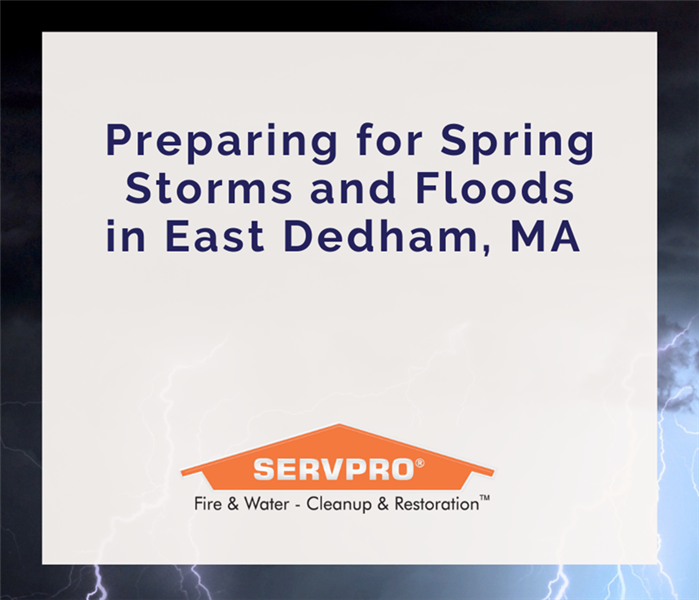 By following these tips, you can better prepare yourself and your home for spring storms in West Roxbury, MA.
By following these tips, you can better prepare yourself and your home for spring storms in West Roxbury, MA.
As the season transitions to spring, West Roxbury, MA, welcomes delightful weather. However, alongside the beauty of the season, there's also the potential for unpredictable and severe storms. For homeowners in the area, being prepared for these events is crucial to safeguarding your family and property. Here's a guide on what you can do before, during, and after a spring storm to stay safe and minimize damage.
Before the Storm:
- Create an Emergency Kit: Assemble essentials such as water, non-perishable food, flashlights, batteries, a first aid kit, and medications
- Develop a Family Communication Plan: Establish how to reach each other and designate a meeting place if separated.
- Secure Outdoor Items: Bring in or secure outdoor furniture, decorations, and other items that could become projectiles in high winds.
- Trim Trees and Shrubs: Reduce the risk of branches falling onto your home during a storm.
- Check Insurance Coverage: Ensure your homeowners insurance policy provides adequate coverage for potential storm damage.
During the Storm:
- Stay Informed: Monitor weather reports and safety advisories to stay updated on the storm's progress.
- Seek Shelter: If advised, seek shelter in a safe place like a basement or interior room on the lowest level.
- Avoid Windows and Doors: Steer clear of these areas to avoid injury from flying debris.
- Turn Off Utilities: If instructed, turn off gas, electricity, and water to prevent damage from flooding or a gas leak.
After the Storm:
- Assess Damage: Check your property for leaks, structural damage, and fallen trees or power lines.
- Document Damage: Take photos of any damage for insurance purposes.
- Contact Your Insurance Company: Report any damage and begin the claims process.
- Clean Up Safely: Wear protective gear and be cautious of hazards like downed power lines when cleaning up debris or water.
By following these tips, you can better prepare yourself and your home for spring storms in West Roxbury, MA. Remember, safety should always be your top priority during severe weather events. If you need assistance with storm damage restoration, SERVPRO of Norwood / West Roxbury is here to help. Stay safe!
Westwood, MA | Dedham, MA | West Roxbury, MA | Norwood, MA | East Dedham, MA | Norwood Centre, MA | Endicott, MA | Walpole, MA
What can storm damage do to a home?
4/7/2023 (Permalink)
 It's important to be aware of the potential dangers of storm damage and take steps to protect your home.
It's important to be aware of the potential dangers of storm damage and take steps to protect your home.
It's important to be aware of the potential dangers of storm damage and take steps to protect your home.
Here are some of the most common types of storm damage that can affect a home:
- Roof Damage: High winds, hail, and heavy rain can all cause damage to a home's roof. This can include missing or broken shingles, leaks, and even complete roof collapse in extreme cases.
- Water Damage: Flooding, leaks, and standing water can cause extensive water damage to a home. This can lead to structural damage, mold growth, and other issues.
- Structural Damage: High winds, tornadoes, and other severe weather events can cause significant structural damage to a home. This can include damage to walls, foundations, and support beams, which can compromise the safety of the home.
- Window and Door Damage: High winds and hail can damage windows and doors, leaving your home vulnerable to further damage.
- Electrical Damage: Lightning strikes and power surges can damage electrical systems in a home, leading to fire hazards and other safety concerns.
- Tree Damage: Falling trees and branches can cause extensive damage to a home, including damage to the roof, walls, and other structures.
- Car Damage: In severe storms, cars can be lifted or moved by high winds, causing them to crash into homes and other structures.
Severe storms can cause a wide range of damage to homes, from minor to severe. By being proactive and taking steps to protect your home, you can minimize the damage caused by severe storms and keep your family safe.
We service Dedham, East Dedham, Endicott, Medfield, Norwood Centre, Norwood, Walpole, MA, and Westwood, MA
SERVPRO Of Norwood West Roxbury is The #1 Choice in Cleanup and Restoration for residential and commercial buildings’ fire, mold, water, and storm damage.
What should I do if my house is affected by storm damage in Norwood West Roxbury?
3/7/2023 (Permalink)
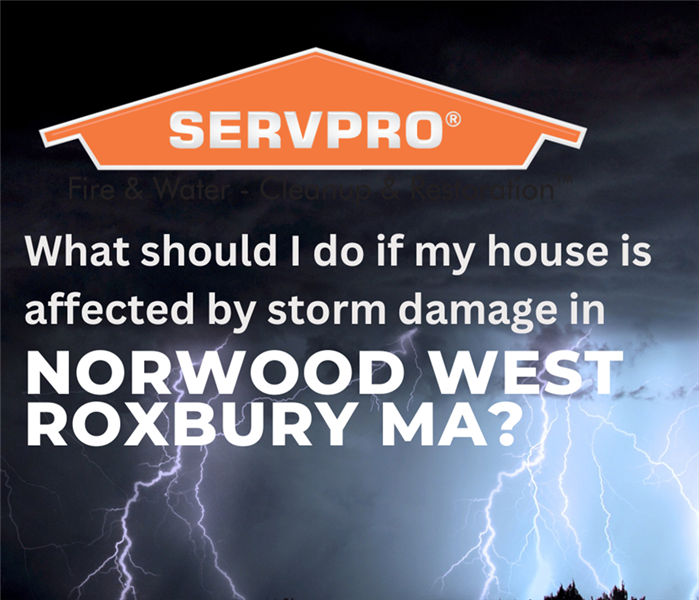 We service Dedham, East Dedham, Endicott, Medfield, Norwood Centre, Norwood, Walpole, MA, and Westwood, MA
We service Dedham, East Dedham, Endicott, Medfield, Norwood Centre, Norwood, Walpole, MA, and Westwood, MA
If your home has been affected by storm damage, it's crucial to act quickly to minimize the damage and ensure the safety of yourself and your family. :
- Assess the damage and prioritize safety: If your home has suffered severe damage, it may be unsafe to stay inside. Look for signs of structural damage, such as cracks in the walls, ceilings, or foundation, and assess the damage to the roof, windows, and doors.
- Document the damage: Take photos and videos of the damage to your home, both inside and out. This documentation will be important when filing an insurance claim.
- Contact your insurance company: Your insurer will likely send an adjuster to assess the damage and determine the amount of compensation you're entitled to.
- Make temporary repairs: Cover any holes in the roof or walls with tarps or boards, and use sandbags or other materials to block any openings where water could enter your home.
- Hire a reputable contractor: Look for contractors who are licensed and insured, and who have experience with storm damage repairs.
- Stay organized: Keep track of all communication with your insurance company and contractor, including emails, phone calls, and written correspondence. Make note of any promises or agreements made, and keep copies of all paperwork related to the claims process.
- Prepare for future storms: Consider adding storm shutters or reinforcing your roof to make it more resistant to high winds. Keep important documents in a waterproof and fireproof safe, and have an emergency kit ready in case you need to evacuate quickly.
Storm damage can be a stressful and overwhelming experience, but taking these steps can help you navigate the process and get your home back to normal as soon as possible.
We service Dedham, East Dedham, Endicott, Medfield, Norwood Centre, Norwood, Walpole, MA, and Westwood, MA
SERVPRO Of Norwood West Roxbury is The #1 Choice in Cleanup and Restoration for residential and commercial buildings’ fire, mold, water, and storm damage.
What types of storms are there in spring Norwood West Roxbury?
3/7/2023 (Permalink)
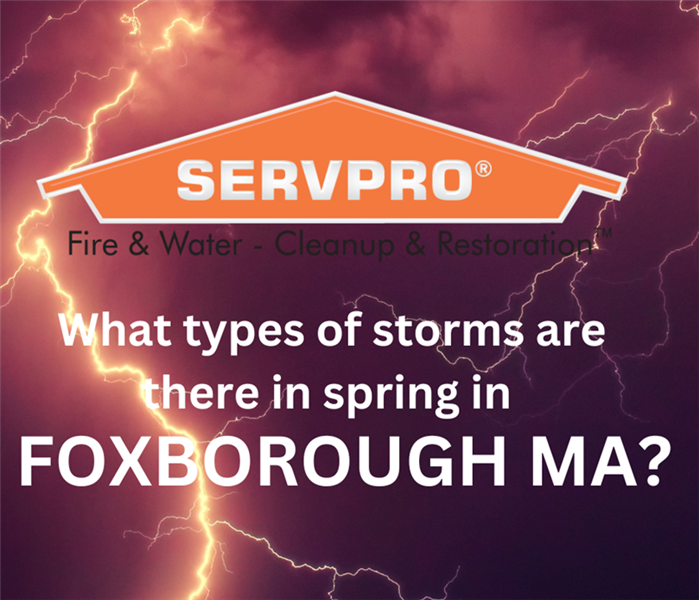 The spring season can bring with it a variety of weather patterns, including rainstorms, thunderstorms, tornadoes, and dust storms.
The spring season can bring with it a variety of weather patterns, including rainstorms, thunderstorms, tornadoes, and dust storms.
As the season transitions from winter to spring, it brings with it a variety of weather patterns that can be unpredictable and sometimes dangerous.
- Rainstorms are characterized by heavy rainfalls, which can last for several hours or even days. They often occur as warm, moist air from the south collides with colder air from the north, leading to the formation of cumulonimbus clouds.
- Thunderstorms are characterized by the presence of thunder and lightning, which are caused by the discharge of electrical energy between the ground and the atmosphere. Thunderstorms can be dangerous, with the potential to produce strong winds, hail, and tornadoes.
- Tornadoes are characterized by a rotating column of air that forms within a thunderstorm and can cause widespread damage, including uprooting trees, damaging buildings, and even destroying entire communities. While tornadoes can occur at any time of the year, they are most common during the spring season.
- While not as common as the other types of storms on this list, dust storms can occur during the spring season in arid regions. These storms are characterized by strong winds that pick up dust and dirt, leading to reduced visibility and potentially hazardous driving conditions.
The spring season can bring with it a variety of weather patterns, including rainstorms, thunderstorms, tornadoes, and dust storms.
We service Dedham, East Dedham, Endicott, Medfield, Norwood Centre, Norwood, Walpole, MA, and Westwood, MA
SERVPRO Of Norwood West Roxbury is The #1 Choice in Cleanup and Restoration for residential and commercial buildings’ fire, mold, water, and storm damage.
What should I do to prepare for a thunderstorm?
3/7/2023 (Permalink)
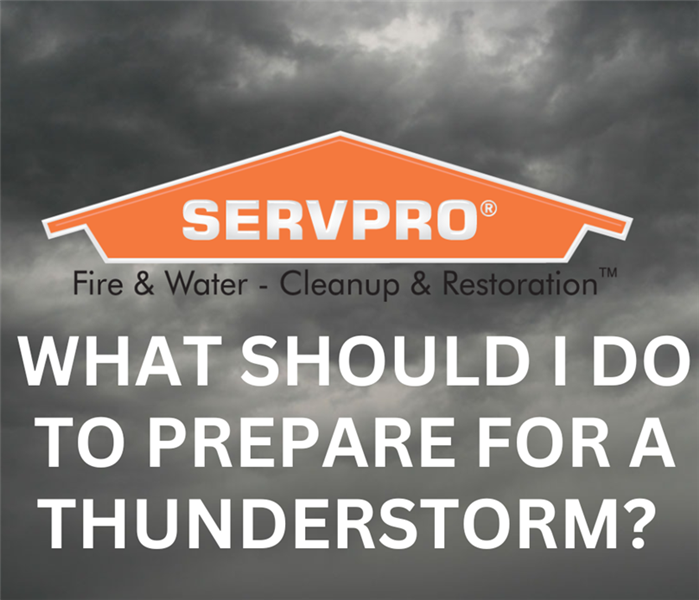 Preparing for a thunderstorm is essential to keeping yourself and your loved ones safe.
Preparing for a thunderstorm is essential to keeping yourself and your loved ones safe.
Thunderstorms are powerful weather events that can bring lightning, high winds, heavy rain, and hail.
- One of the most important things you can do to prepare for a thunderstorm is to stay informed about the weather conditions in your area. Keep an eye on local weather reports and download a reliable weather app that can give you up-to-date information.
- Create an emergency kit: Putting together an emergency kit is an excellent way to prepare for a thunderstorm. Your kit should include items like a flashlight, extra batteries, a first aid kit, bottled water, non-perishable food, a portable radio, and a phone charger.
- Secure your home: It is essential to secure your home before a thunderstorm.
- Unplug electronics: Lightning strikes can cause power surges that can damage your electronic devices. To prevent this, unplug your electronics before the storm arrives. This includes appliances, televisions, computers, and other devices.
- Stay inside: The best way to stay safe during a thunderstorm is to stay inside a sturdy building or a car. If you are outside when the storm hits, seek shelter immediately.
- Wait for the storm to pass: Thunderstorms can be intense but usually pass relatively quickly. Once the storm has passed, wait for a while before going outside to assess any damage or potential hazards.
Preparing for a thunderstorm is essential to keeping yourself and your loved ones safe. Staying informed, creating an emergency kit, securing your home, unplugging electronics, staying inside, and waiting for the storm to pass are all critical steps to take.
We service Dedham, East Dedham, Endicott, Medfield, Norwood Centre, Norwood, Walpole, MA, and Westwood, MA
SERVPRO Of Norwood West Roxbury is The #1 Choice in Cleanup and Restoration for residential and commercial buildings’ fire, mold, water, and storm damage.
SERVPRO of Norwood West Roxbury Explains Winter Storm Damage
2/5/2023 (Permalink)
 Winter storms can bring both beauty and danger. By taking the necessary precautions and being prepared, you can protect your property from winter.
Winter storms can bring both beauty and danger. By taking the necessary precautions and being prepared, you can protect your property from winter.
Winter storms can bring both beautiful snow and dangerous ice. This can also cause significant damage to homes and businesses. Here are some common types of winter storm damage and tips for protecting your property.
- Roof damage: Heavy snow and ice can put a lot of weight on your roof, which can cause damage, including cracks, leaks, and even collapse. Regularly removing snow and ice from your roof can help prevent damage.
- Frozen pipes: When pipes freeze, they can burst and cause significant water damage to your home or business. To prevent this, make sure your pipes are properly insulated and kept at a temperature above freezing.
- Power outages: Winter storms can bring high winds and heavy snow that can cause power outages. Have backup power sources, such as a generator, on hand to ensure that you have power during a winter storm.
- Slips and falls: Ice and snow can make walkways and steps slippery, which can lead to falls and injury. Keep walkways and steps clear of snow and ice to prevent accidents.
- Vehicle damage: Winter storms can cause damage to your vehicle, including dents, scratches, and even engine damage. Store your vehicle in a garage or covered area to protect it from winter weather.
Regularly inspect your home or business for potential damage and make any necessary repairs. If a winter storm is forecasted, take steps to secure your property, such as removing loose objects, reinforcing windows and doors, and stocking up on supplies.
In the event that winter storm damage occurs, it is important to act quickly to prevent further damage.
Winter storms can bring both beauty and danger. By taking the necessary precautions and being prepared, you can protect your property from winter storm damage.
SERVPRO of Norwood West Roxbury is your premier choice for fire damage and restoration. Our teams are ready to respond 24 hours a week, any day of the year. When you bring us on the job our team of licensed contractors and certified technicians will work collaboratively with you throughout the duration of the project. They will keep you updated on the project's status and ensure that your expectations are met. We will help you to move forward and make it “Like it never even happened” for all of your fire damage.
SERVPRO of Norwood West Roxbury Shares Storm Safety
9/16/2022 (Permalink)
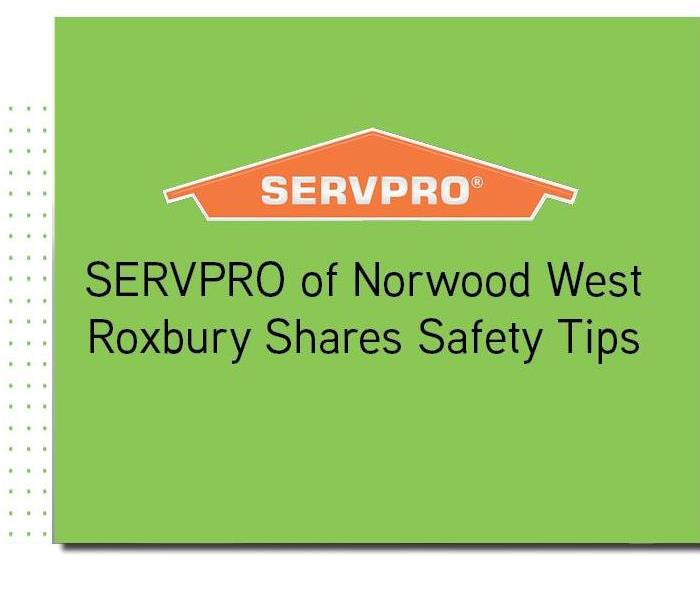 Everyone should be prepared in case of a disaster, as best as they can be.
Everyone should be prepared in case of a disaster, as best as they can be.
Everyone should be prepared in case of a disaster, as best as they can be. If you haven't taken the time to think about how disasters could effect you, then it is time to become educated to help save you and your family.
- Make sure you are always informed, and receive important lifesaving alerts from your local community.
- You can also receive wireless emergency alerts such as a NOAA Weather Radio, or follow social media.
- Know which natural disasters can occur in your area and how to prepare in advance.
- Make sure you know where the nearest shelters are. You might also want to know evacuation routes.
- It is important to make a family emergency plan that can be put into action.
SERVPRO of Norwood West Roxbury is your premier choice for restoration and rebuild. Our teams are ready to respond 24 hours a week, any day of the year. When you bring us on the job our team of licensed contractors and certified technicians will work collaboratively with you throughout the duration of the project. They will keep you up to date on the status of the project and make sure that your expectations are met. We will help you to move forward and make it “Like it never even happened” for all of your storm damages.
What To Do If Your House Floods in SERVPRO of Norwood West Roxbury
7/3/2022 (Permalink)
 Planning for a flood due to a storm is difficult, but you can take some small precautions to ensure your home is protected
Planning for a flood due to a storm is difficult, but you can take some small precautions to ensure your home is protected
Planning for a flood due to a storm is difficult, but you can take some small precautions to ensure your home is protected:
- Keep your rain gutters and downspouts clear of leaves and debris.
- Ensure downspouts direct water away from your basement or foundation.
- Be certain the ground slopes are away from your home.
- Watch for small leaks in your roof, windows, doors, and foundation and fix them promptly.
When the rain is extremely hard and lasts for a long time, this can cause water levels to rise, which will flood your home. Sandbagging and trenching can help in some cases, but if water finally does start getting into your home, further action steps are needed.
“What do I do if I get water in my basement?”
At the first sign, that water is entering your home, cut the power to all outlets. Don’t forget to Unplug all machines and equipment such as freezers, heaters, lamps, and power tools. Put washers, dryers, freezers, etc. up on blocks to keep them out of the rising water.
- If water has entered your home quickly contact your local utility company to cut the power to your home
- If you have an electric sump pump, it is important that it stays plugged in. Shut off the gas or have your gas company do it for you if you aren’t sure how to do it.
- A backup generator can be used to power additional pumps, water vacuums, and lights. Make sure that water has been cleaned up and isn’t destroying surrounding things.
- Contact your insurance company as soon as possible.
- Install fans to move air and dry your basement once the bulk of the water is gone.
- Contact a qualified flood restoration expert such as SERVPRO of Norwood West Roxbury to determine what steps are necessary to repair your home from flood damage.
We are proud to serve our local communities:
- Westwood, MA
- Dedham, MA
- West Roxbury, MA
- Norwood, MA
- East Dedham, MA
- South Norwood, MA
- Norwood Centre, MA
- Endicott, MA
- Riverdale, MA
- Midtown Bus District, MA
- Walpole, MA
- Medfield, MA
SERVPRO of Norwood West Roxbury is available 24/7 including holidays and weekends to assist you with your disaster needs to get it back to “Like it never even happened.”
SERVPRO of Norwood West Roxbury Talks Hail Storm Safety
7/3/2022 (Permalink)
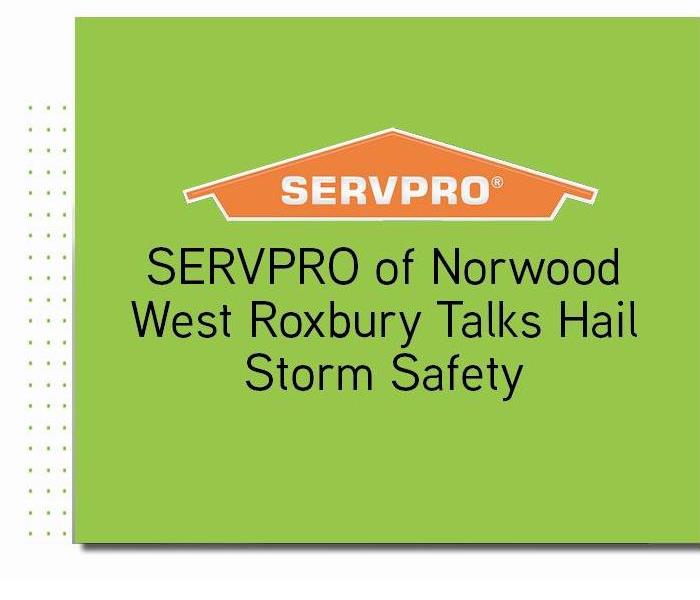 Hail can dent vehicles, shatter windows and destroy roofs. This can cause water damage in your home.
Hail can dent vehicles, shatter windows and destroy roofs. This can cause water damage in your home.
Hail is common during severe thunderstorms. Hail can dent vehicles, shatter windows and destroy roofs. This can cause water damage in your home.
Minimize hail damage with these helpful tips:
- Clear your debris to minimize water damage.
- Inspect your roof for damage and repair areas.
- Remove weak branches or trees close to your home.
- Store patio furniture in an enclosed space.
- Move vehicles into a garage or use a hail protector cover.
- Avoid finding shelter under trees or in areas that can suddenly fill with water.
- Stay indoors and away from windows or glass doors.
- Close blinds to protect yourself from broken glass and debris.
- After the storm, if there’s a power outage, turn off electronics and appliances.
- Use a flashlight instead of candles.
- Turn off valves, if you detect any gas leaks.
- Clean up debris and make temporary repairs.
If your home has been damaged:
- Document the damage as soon as possible.
- Take photos or make a video.
- Keep records for clean-up costs complete.
- Document everything for your insurance company.
We are proud to serve our local communities:
- Westwood, MA
- Dedham, MA
- West Roxbury, MA
- Norwood, MA
- East Dedham, MA
- South Norwood, MA
- Norwood Centre, MA
- Endicott, MA
- Riverdale, MA
- Midtown Bus District, MA
- Walpole, MA
- Medfield, MA
SERVPRO of Norwood West Roxbury is available 24/7 including holidays and weekends to assist you with your disaster needs to get it back to “Like it never even happened.”
SERVPRO of Norwood West Roxbury Shares Thunderstorm Tips
6/1/2022 (Permalink)
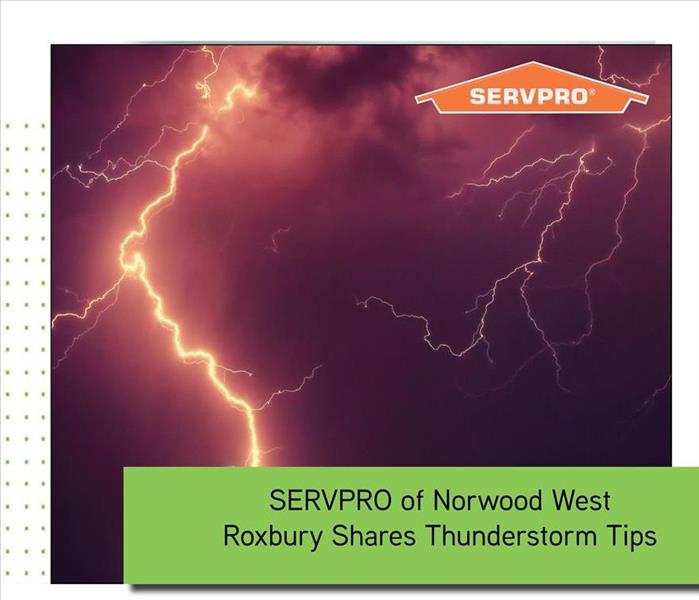 The summer months are here, and with that comes thunderstorms. They can be dangerous for many reasons, it is important to know how to protect yourself
The summer months are here, and with that comes thunderstorms. They can be dangerous for many reasons, it is important to know how to protect yourself
The summer months are here, and with that comes thunderstorms. They can be dangerous for many reasons, it is important to know how to protect yourself and your loved ones during a thunderstorm.
Thunderstorms can happen quickly and you might find yourself outdoors. If you are outdoor and see lightning and hear thunder find shelter immediately.
Here are some Safety precautions for indoors”
- Avoid contact with water during a thunderstorm. Do NOT bathe, shower, wash dishes, or have any other contact with water.
- Avoid using electronic equipment of all types; lightning can travel through electrical systems.
- Avoid using corded phones. However, cordless or cellular phones are safe to use during a storm.
- Do NOT lie on concrete floors during a thunderstorm. Lightning can travel through any metal wires or bars in concrete walls or flooring.
Lightning strikes may be rare, but they still happen and the risk of severe injury is severe.
SERVPRO of Norwood West Roxbury is available 24/7 including holidays and weekends to assist you with your disaster needs to get it back to “Like it never even happened.”
SERVPRO of Norwood West Roxbury Shares Summer Tips
6/1/2022 (Permalink)
 Summer is finally here! We know that can mean summer fun outdoors, but summer can also bring the threat of dangerous storms.
Summer is finally here! We know that can mean summer fun outdoors, but summer can also bring the threat of dangerous storms.
Summer is finally here! We know that can mean summer fun outdoors, but summer can also bring the threat of dangerous storms. Learn how to reduce your lightning risk while outdoors.
“If you hear thunder, lightning is close enough to pose an immediate threat,” said FEMA Region V Acting Administrator Janet M. Odeshoo.
Seek shelter as quickly as possible. There is no safe place outside when a thunderstorm is in the area.”
Buildings such as offices, schools, and homes offer good protection. Once inside, stay away from windows and doors and anything that conducts electricity. If you are caught outside with no safe shelter anywhere nearby, consider these options:
- Never shelter under an isolated tree, tower, or utility pole.
- Immediately get off elevated areas such as hills, mountain ridges, or peaks.
- Immediately get away from ponds, lakes, and other bodies of water.
- Stay away from objects that conduct electricity.
- Never lie flat on the ground.
The best way to protect yourself against lightning injury is to monitor the weather and postpone outdoor activities when thunderstorms are in the forecast. Lightning can strike from up to 10 miles away. If you can hear thunder, you might be in danger of being struck by lightning.
SERVPRO of Norwood West Roxbury is available 24/7 including holidays and weekends to assist you with your disaster needs to get it back to “Like it never even happened.”
SERVPRO of Norwood West Roxbury Explains Summer Storm Safety
5/10/2022 (Permalink)
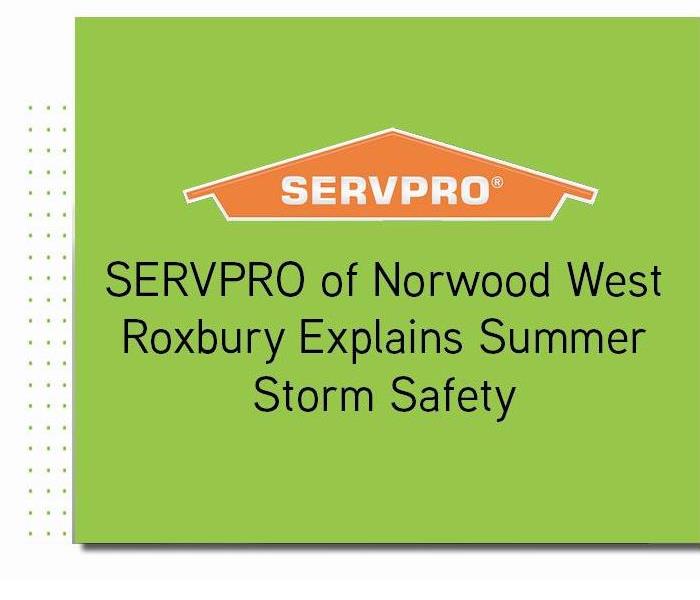 Summer is just around the corner, so the threat of dangerous storms increases. There are ways to reduce your lightning risk while outdoors.
Summer is just around the corner, so the threat of dangerous storms increases. There are ways to reduce your lightning risk while outdoors.
Summer is just around the corner, so the threat of dangerous storms increases. There are ways to reduce your lightning risk while outdoors.
Buildings such as offices, schools, and homes should have good protection. Once you are inside, stay away from windows and doors. Make sure to stay away from anything that conducts electricity.
If you have no safe shelter anywhere nearby, the following actions may reduce your risk:
- Never shelter under an isolated tree or utility pole.
- Get off hills, mountain ridges, or peaks.
- Get out and away from ponds, lakes, and water.
- Stay away from objects that conduct electricity.
- Don’t lie flat on the ground.
- Make sure to postpone or cancel outdoor activities when thunderstorms are in the forecast.
Always make sure that you are safe at all times; even if your building is damaged. We are here to help you with the damage that can be caused by storm damage.
SERVPRO of Norwood West Roxbury is available 24/7 including holidays and weekends to assist you with your disaster needs to get it back to “Like it never even happened.”
SERVPRO of Norwood West Roxbury Shares 5 Ways to Protect For Spring Storms
4/6/2022 (Permalink)
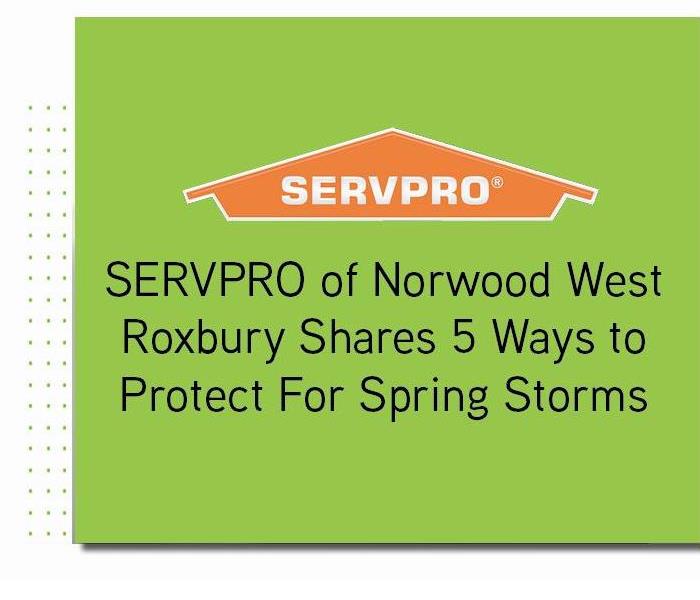 The combination of heavy rainfall and ice melting can produce large amounts of runoff.
The combination of heavy rainfall and ice melting can produce large amounts of runoff.
When spring arrives flooding can arise. The combination of heavy rainfall and ice melting can produce large amounts of runoff. This leads to large amounts of water and flooding.
Water damage is not a cheap fix, it is important to be aware of what you can do to protect yourself. Follow these five tips to protect your home from flooding this spring.
- Learn from the past: If your house has leaked before, it has a higher risk of it happening again. You will want to repair any cracks in your walls or foundation.
- Clear out debris: Built-up debris in your gutters can go through window wells. This may keep water from draining away from your home properly. Keep these areas free from debris as best as you can to prevent flooding.
- Get your pump ready: Make sure your sump pump is working properly. You will also want to make sure you have a battery or backup power source. You may also consider installing a back-water valve; this will prevent flooding from sewer backup.
- Check for leaks from above: Damaged shingles can be an easy entry point for water during a storm. Inspect your roof to make sure you don’t get water damage.
- Give the water somewhere to go: Ensure that there is a place to direct water away from your home. If you notice water around your home, try getting your yard re-graded or use downspout extensions.
SERVPRO of Norwood West Roxbury is available 24/7 including holidays and weekends to assist you with your commercial disaster needs to get it back to “Like it never even happened.”
SERVPRO Norwood West Roxbury discusses National Preparedness Month
9/15/2021 (Permalink)
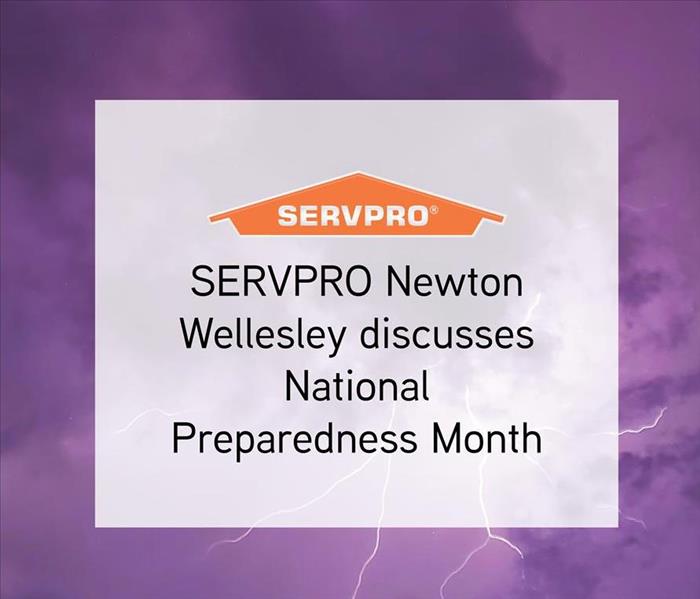 Natural disasters can happen to any home or business. It is important to be aware of the different types of disasters, and know if you can be affected
Natural disasters can happen to any home or business. It is important to be aware of the different types of disasters, and know if you can be affected
Natural disasters can happen to any home or business. It is important to be aware of the different types of disasters, and know if you can be affected by any of them.
Wildfires: If there is a wildfire in the area, be ready to evacuate quickly since they spread rapidly.
Hurricanes: Make sure to know where to go if asked to evacuate and how you will get there; it is important to act fast.
Flooding: If you approach a flooded road, turn around, don't think you can handle it.
Drought: Learn to make conserving water a part of your daily life.
Extreme Heat Temperatures: Drink plenty of water; heat exhaustion is not good for your body.
Always make sure to have a cell phone plugged into a backup battery pack if you know a disaster is coming.
SERVPRO of Norwood West Roxbury is available 24/7 including holidays and weekends to assist you with your home restoration needs to get it back to “Like it never even happened.”
Summer Flooding Tips in Norwood West Roxbury
7/12/2021 (Permalink)
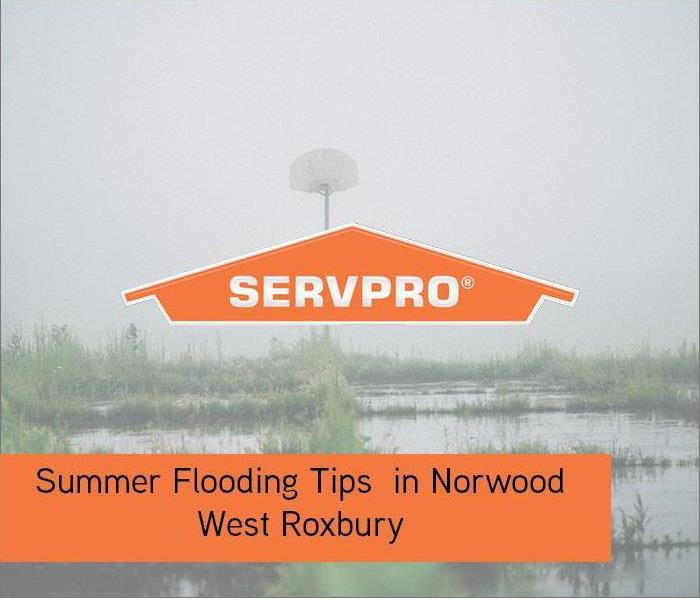 Summer is the time of year when flooding happens a lot. This can cause damage to any residential or business building.
Summer is the time of year when flooding happens a lot. This can cause damage to any residential or business building.
Summer is the time of year when flooding happens a lot. This can cause damage to any residential or business building. Here are some great tips should flooding happen:
- Find safe shelter right away.
- Do not walk or drive through flood waters.
- Stay off bridges over fast-moving water.
- Evacuate if told to do so.
- Check up on flood insurance policy.
- Make a plan for your household, including your pets.
- Learn and practice evacuation routes and shelter plans.
- Gather supplies: non-perishable foods, cleaning supplies, and water for several days.
- Move valuables to higher levels.
- Check on your sump pump.
Flooding can happen quickly, it is important to make sure to get notifications from your local weather channels so you can act quickly too. Be careful if you have a flood warning!
SERVPRO of Norwood West Roxbury is available 24/7 including holidays and weekends to assist you and get your home back to “Like it never even happened.”
Hurricane Season Safety Tips in Norwood West Roxbury
7/12/2021 (Permalink)
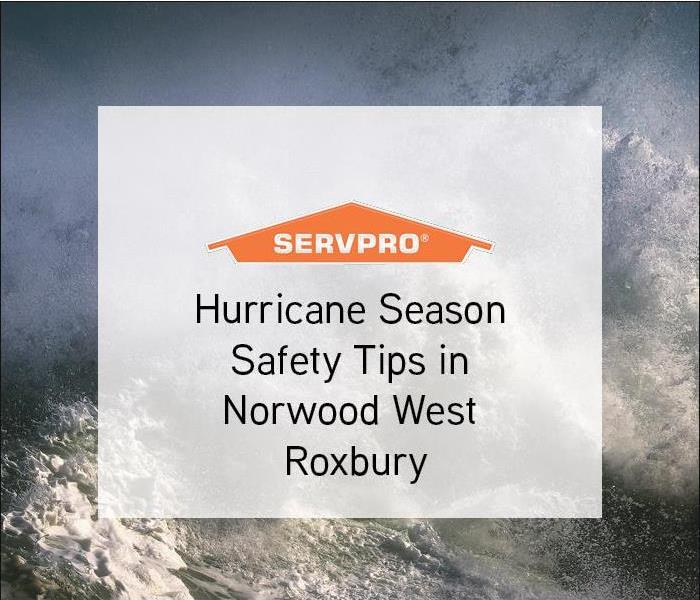 By now, we have been getting major weather effects from hurricane season and it may cause damage to your home or business.
By now, we have been getting major weather effects from hurricane season and it may cause damage to your home or business.
By now, we have been getting major weather effects from hurricane season and it may cause damage to your home or business. There are some things you can do in preparation should a hurricane, or storm weather hits.
- Create a plan with your family: Whether it’s the possibility of tornadoes, hurricanes, or floods families need to be prepared. A plan should include evacuation routes, emergency numbers, shelter possibilities, and a communication strategy.
- Build a disaster kit: The kit should have basics: bottled water, non-perishable snacks, flashlights, batteries, sanitation items, important documents, and first aid kits.
- Practice the plan: You will want to practice evacuation routes, shelter areas, and memorizing emergency numbers.
- Stay informed: You will want to keep your family safe, so staying informed is critical. When a major disaster occurs, it is advised that everyone should have a reliable resource for emergency alerts: phone apps or emergency radio.
- Tackle storm anxiety: Creating a plan is the first step in tackling anxiety. Make sure to allow your child to talk through their fears and concerns.
SERVPRO of Norwood West Roxbury is available 24/7 including holidays and weekends to assist you to get your home back to “Like it never even happened.”
Are You Storm Ready?
6/1/2021 (Permalink)
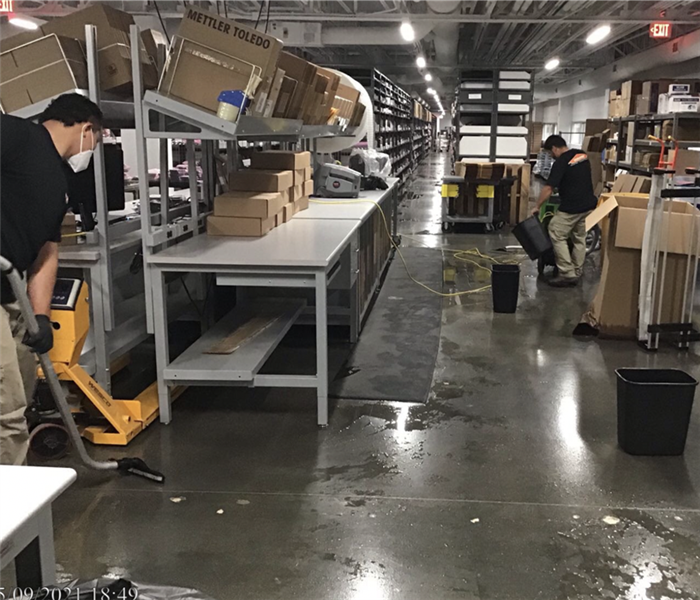 Storm can strike at any moment, like it did in this warehouse in Westwood, MA.
Storm can strike at any moment, like it did in this warehouse in Westwood, MA.
Not many of us plan for disasters, natural or man-made. When they happen, people may say things like, “But I never saw it coming,” and “We didn’t have time to react.” Well, the time for action is long before a tragedy befalls you or your property!
According to FEMA, there are four main ways to prepare for storms you can and should do now:
- Get informed
- Make a plan
- Assemble a kit
- Maintain your plan and kit
- Get Informed - Many areas have local emergency management offices and/or a Red Cross Chapter. These organizations can provide you vital information concerning local emergency response arrangements, evacuation plans and emergency shelters. It’s also a good idea to invest in a NOAA Weather Radio that will alert you during any time of the day or night for when possible destructive conditions materialize.
- Make a Plan
- Conduct a family meeting that will inform everyone what your emergency plans are.
- Have an out-of-town contact that each one knows the number to. This is who you’ll call to inform where you are after a disaster strikes.
- Teach your children how and when to call emergency numbers.
- Have a prearranged location picked out as the place your family will meet in case you get separated from one another. Make sure everyone knows not only the best escape routes but the safe places to go inside your home if a tornado approaches.
- Know how and when to turn off water, gas and electricity at the main switches or valves.
- Have fire extinguishers ready and show everyone where they’re located and how to use them.
- Inventory your possessions and keep that list along with important documents in a safe deposit box.
- Keep your homeowners or renter’s insurance company’s telephone numbers readily available. (Also, be sure to keep SERVPRO of Norwood/West Roxbury's phone number close at hand!)
- Assemble a Kit – this is a collection of basic family needs you’ll need after a disaster. These should be stored in a portable container and enough to last you three days. It should include food, water, a battery powered radio, a flashlight, etc. You can find a full list of items for your survival kit at redcross.org.
- Maintain Your Plan – every six months, review your plans with your family, conduct evacuation drills and restock expiring food and perishables in your kit. Also, confirm your fire extinguisher is recharged and smoke alarm batteries are replaced.
Wind Storm Basics
6/1/2021 (Permalink)
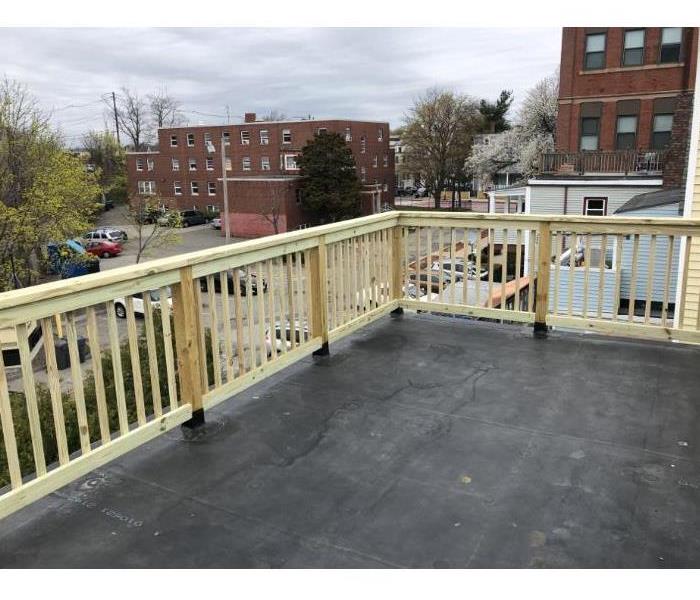 A rubber roof top deck with a sturdy railing built by our rebuilds team in Norwood, MA
A rubber roof top deck with a sturdy railing built by our rebuilds team in Norwood, MA
There are many concerns that come with severe storms, with the threat of damaging winds being one of them. These winds can come with little to no notice and have long-term structural impacts.
While many think of damaging winds as a result of a tornado or a hurricane, those are not the only times when they can occur. Traditionally, damaging winds are considered those with wind speeds exceeding 50–60 mph and can stem from a strong thunderstorm. You will often hear damaging winds referred to as “straight-line” winds, differentiating them from the winds caused by a tornado.
The damage from these winds can be especially destructive. Straight-line winds can pick up loose objects in your yard and cause those objects to become projectiles.
Windows and the roof can take the brunt of this damage, and the wind damage is extensive enough, water damage can result as the outside elements are able to come indoors.
Anyone who lives in a thunderstorm-prone area can be at risk from damaging winds, but some structures are more susceptible to damage and are especially at risk. Mobile homes, even anchored mobile homes, can sustain extensive damage in wind gusts over 80 mph.
How to Protect Your Home From Damaging Winds
Here are some of the ways you can help protect your property from damaging winds. Always keep the “Two R’s” in mind: reinforce and remove.
Ask a professional to reinforce your garage door.
Remove or anchor loose objects on your property that could easily turn into projectiles by the wind. Don’t forget trash cans, grills and outdoor furniture.
Hire a professional to remove large or dying trees and branches that may fall on your home.
Not all high wind circumstances come with forewarning, but incorporating some of these suggestions keep your prepared for that “just in case” moment.
Also, if you are building a new home or renovating an older home, check to be sure the windows, walls and doors are up to code for your area.
Should your home be hit by damaging winds and resulting water damage, our highly trained specialists at SERVPRO of Norwood/West Roxbury are here to help with the cleanup and restoration of your home
Spring Storm Tips for Norwood West Roxbury MA
5/29/2021 (Permalink)
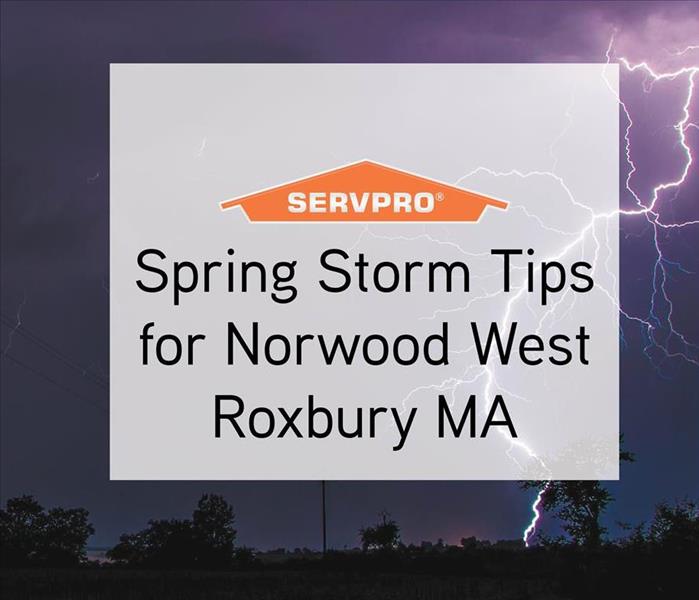 SERVPRO of Norwood West Roxbury is available 24/7 including holidays and weekends to assist you with your storm needs. Call (781) 769-9125
SERVPRO of Norwood West Roxbury is available 24/7 including holidays and weekends to assist you with your storm needs. Call (781) 769-9125
Storms can cause a lot of damage to your home; it is important to prepare for it as best as you can. Here are some preparations that you can make before a storm hits.
- Build an Emergency Kit with essential items. Make sure to add water, food, a battery-powered or hand-crank radio, a flashlight to name a few. The Federal Emergency Management Agency (FEMA) has a detailed checklist available.
- Eversource also has a storm safety checklist available to help.
- Stock up on non-perishables, such as canned goods and pet food. You should also make sure you have adequate medical supplies and prescriptions for everyone in the household.
- You will want to pick up paper goods such as paper plates, paper towels, plastic ware in case you lose power.
- If you have a power outage, turn the temperature control on your refrigerator and freezer to the coldest setting.
- You should fill several large containers with water for drinking.
- Make sure to keep flashlights, batteries, candles, and matches on hand.
- Make sure you have batteries that are the correct size for the flashlights and other important electronics.
- Check to make sure there’s a first aid kit in the house.
- Fill your car with gasoline, so if you need to go anywhere you are prepared.
- If you lose power, you will want to cook outside. You can use charcoal or propane grills or even a camping cookstove.
- You will want to have a list of emergency phone numbers on hand: Red Cross, fire, police, and a family doctor.
SERVPRO of Norwood West Roxbury is available 24/7 including holidays and weekends to assist you with your storm needs. Call (781) 769-9125
Here To Help After The Storm
4/7/2021 (Permalink)
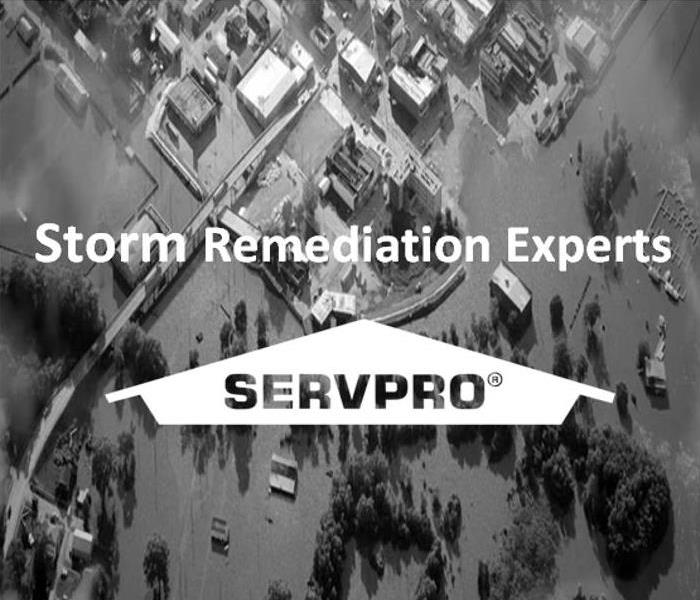 When storm damage strikes your commercial property SERVPRO of Norwood/West Roxbury is here to help our community.
When storm damage strikes your commercial property SERVPRO of Norwood/West Roxbury is here to help our community.
Research shows since 1980, the occurrence of weather-related disasters has increased by more than 230 percent. According to AccuWeather, natural disasters have affected at least 217 million people every single year since 1990. When a storm wreaks havoc on your commercial property you need help from a company that can handle any size of the disaster. SERVPRO of Norwood/West Roxbury is that company.
Our Disaster Remediation Teams have access to a fleet of vehicles and a 4,000 square foot warehouse full of professional-grade, state-of-the-art equipment. Our main facility is located right of 495 which means that we can arrive onsite within hours of receiving your call. Every large loss is supervised by one of our Project Managers to help ensure seamless communication and timely mitigation. Our Teams are on call 24 hours a day, every day of the year, including holidays. Our clients do not have to wait till the next business day for us to arrive.
When storm damage strikes your commercial property SERVPRO of Norwood/West Roxbury is here to help our community. No matter what your needs may be, we have a commercial-sized solution for you. Call us today - (781) 769-9125. We will make it, "Like it never even happened."
Is Your Roof A Storm Risk?
9/10/2020 (Permalink)
A well-built roof can last for 30 years or more. Over time, the roof will start to wear out and show its age. Also, severe weather, such as heavy storm winds and hail can cause significant damage to even newly installed roofs. Minor damage is all it takes to cause a roof leak. What is worse, small amounts of moisture, over long periods of time, will result in mold growth. It is a good idea to routinely check the roof of your Westwood, MA commercial or residential property for signs of any damage.
Signs of Roof Problems
It is wise building inspect the roof of your commercial or residential property at least once a year. Here are some signals that your roof could be leaking or have other issues:
- There are missing shingles.
- Some of the shingles are curling.
- Asphalt shingle granules are in the rain gutters.
- There are water stains on your ceiling.
Get Rid of Wet Materials
If you do have a damaged roof, make sure you remove water damaged materials immediately. Be sure to file an insurance claim and then call the Disaster Remediation Team at SERVPRO of Norwood and West Roxbury to guide you through the process. Our certified technicians will identify the materials and contents that are salvageable, professionally remove the materials and contents that are not, remove any remaining moisture in the affected area.
Dry and Sanitize
Once everything is out of the way, the professionals will thoroughly dry the area that the roof leak affected. Technicians will use heavy-duty blowers and dehumidifiers to remove all water and moisture. To further discourage the growth of mold, the technicians will disinfect all applicable areas of the building.
Restoration
The last step in the drying process is to restore damaged materials and rebuild your roof. As a one-stop-shop we are able to offer our clients a seamless transition from remediation to rebuild. Our Rebuild Team of master craftsmen will make it "Like it never even happened," and repair your roof to preloss condition.
We’re Here for You
A roof leak can cause more problems than you might think. The Disaster Remediation and Rebuild Teams at SERVPRO of Norwood/West Roxbury has specialized training and experience in water damage remediation and natural disaster prevention, cleanup, and rebuild. Call SERVPRO of Norwood/West Roxbury at (781) 769-9125 today.
Protecting Your Garden From Storm Damage
7/28/2020 (Permalink)
This is the time of year when those of us with green thumbs enjoy tending to their gardens. Although our gardens love a nice rain shower, too much rain can be harmful to the plants. After all the hard work you have done to manage your garden, do not let heavy rainstorms ruin it!
Follow these tips to protect your garden during heavy storms:
Before
- Remove damaged limbs and shoots – Removing dead limbs and shoots from your plants will help make them more streamlined and will reduce snapping and tangling.
- Add compost and mulch – Adding a couple of inches of compost to the top 8 to 12 inches of soil will help with drainage.
- Support taller plants – Tie taller plant to wooden or metal support. This will help keep them stable against rain and strong winds.
- Drainage – Make sure the grade slopes away from the garden to create proper runoff during rains. Make sure it there is nothing that will impede the water runoff. Water collecting in your garden can be damaging to your plants, possibly drowning them.
During
- Cover you most delicate plants – Hang a waterproof tarp over your most fragile plants during heavy rainstorms to direct the water away from these plants. Make sure that the covering is not blocking water from draining because it can cause other plants to drown.
After
- Check your vegetable roots – Once the rainstorm has stopped check for soil erosion. This may lead to exposed roots. If there are exposed roots, covered them with soil or compost before they dry out.
- Check your pots and planters – Pots and planters can easily become flooded if the drainage is blocked. Check them before, during and after rainstorms. You can always cover pots and planters if necessary.
- Pull weeds up by hand – The moist soil after rain means you are much more likely to retrieve the whole root without it snapping or breaking.
We hope these tips will help your garden to flourish!
Storm damage not only wreaks havoc on our gardens but it can be devastating to our homes too. When storm damage stikes call SERVPRO Norwood/West Roxbury at (781) 769-9125. We will make it "Like it never even happened."
The Professional Grade Equipment Difference
7/23/2020 (Permalink)
Flood Damage in Norwood, MA
Our SERVPRO Disaster Remediation Team can help with useful extraction tools to make drying and cleaning efforts more efficient after flooding in your Norwood, MA commercial or residential property.
Flooding can introduce many immediate threats to the structure of your property, the worst of which is standing water. Depending on the amount and category of (clean or dirty) the water it can be challenging to remove without the right tools and techniques. The certified technicians at SERVPRO Norwood/West Roxbury can help with multiple options designed to manage any size loss scenario quickly!
All too often, property owners do not comprehend the benefits of hiring a professional remediation company. Having our certified technicians begin the drying process quickly will significantly reduce the total damage to the property and its contents. Mitigation and emergency services like extraction require the proper tools and techniques - and we have both!
- Pumps – With a submersible end that can generate a prime to pull standing water from a damaged area, these units are capable of moving thousands of gallons from damaged areas over brief periods.
- Wet Vacuums – When water depths do not exceed two inches, wet vacuums and their various attachments can help to remove surface water and prepare the property for drying.
- Weighted Extraction Tools – Carpeting can absorb high volumes of water before pooling begins on the surface. Weighted extraction units utilize the weight of our technicians to press the top layer and padding into the subflooring. The onboard vacuum removes moisture brought to the surface.
State-Of-The-Art Professional Grade Equipment
It is not unusual for property owners to have a drainage system with submersible pumps already installed. Unfortunately, they are not always the best tool for the job. The proper extraction tool to use is determined by the Category of water that needs to be cleaned up. Natural flooding can introduce substantial debris, silt, and other particulates that electric submersible pumps cannot easily pass. Some of the professional grade equipment that our technicians have access to includes:
- Self-Priming Trash Pump - Trash pumps run on gasoline and diesel fuels, which can make them an ideal option where power is already limited, and other restorative devices can use it. These powerful extractors can pass smaller debris with a larger intake/discharge hose.
- High-Pressure Pump - Similar in function to the electric pumps, high-pressure units can address a greater need for lift and head. These units cannot easily pass debris but can be excellent options for removing flooding in the basement, attic, or other areas that require an extended discharge.
- Electric Submersible Pump - For those instances when our clients do not have one of their own. These units are the standard for removing standing clean water in the house. When flooding occurs through breaches in the roof or openings in the house, we can extract thousands of gallons over a brief period with these capable units.
- Wet Vacuums - With a manageable depth of two inches or less, wet vacuums and their various attachments finalize the removal of surface water. These units can also be capable at greater depths and more substantial losses, when combined with submersible units.
Flooding and its damages can spread quickly throughout the structure of your commercial or residential property. Beginning extraction and drying efforts as soon as possible is an effective way to protect your home and its contents from irreparable damage. When storm damage stikes call SERVPRO Norwood/West Roxbury at (781) 769-9125. We will make it "Like it never even happened."
Protect Your Property From Wind Storms
6/1/2020 (Permalink)
If a hurricane or wind storm is approaching, everything you own outside your house that isn't bolted down is at risk of being damaged or blown around. Patio chairs, tables, umbrellas, grills, free standing hammocks, etc. can become projectiles that could cause significant damage to your Westwood, MA property. Follow these tips to protect your property from wind-tossed projectiles.
Secure Your Outdoor Furnishings
Bring your patio furniture, outdoor toys, container plants, pool cleaning and gardening equipment inside to prevent damage to your house or other parts of your property. Anchor heavier outdoor objects that can't easily be brought inside to something solid with rope, chains, etc.
If possible, bring gas or charcoal grills inside. Important: never use grills inside or store propane tanks inside your home or garage! Chain propane tanks in an upright position to a secure object away from your home, so they don’t get lifted by winds.
Prune Trees and Shrubs
Ideally, you prune dying and weak branches of trees and shrubs throughout the year as part of your regular yard maintenance. If not, do this before the storm to prevent branches from being tossed by powerful winds. Fallen branches branches can cause significant damage to roofs.
If your home or business suffers damage from a natural disaster, call SERVPRO of Manchester/Mansfield today at 860.649.0836
We’re Here for You
If your home or business suffers storm damage from a natural disaster, call the experts of SERVPRO of Norwood/West Roxbury at (781) 769-9125. We will make it, "Like it never even happened."
Coastal Flooding On The Rise
5/28/2019 (Permalink)
Many homeowners dream of waterfront property, the smell of salty sea air and to be greeted by the ocean when the wake up every morning. As idyllic as it may sound there is another side to living on the coast. During 2018 coastal communities experienced record number of high tide flooding. Sidewalks and streets were frequently flooded mainly due to El Nino conditions. The projected increase in high tide flooding in 2018 may be as much as 60 percent higher across U.S. coastlines as compared to typical flooding about 20 years ago, according to NOAA scientists. These predictions are part of NOAA’s 2017 State of High Tide Flooding and 2018 Outlook, a report produced by NOAA’s Center for Operational Oceanographic Products and Services every year since 2014.
The report finds that during the 2017 meteorological year (May 2017-April 2018), the U.S. average number of high tide flooding days was the highest measured at 98 NOAA tide gauges. More than a quarter of the coastal locations tied or broke their individual records for high tide flood days.
The top five cities that saw the highest number of flood days across the U.S. and broke records include Boston; Atlantic City, New Jersey; Sandy Hook, New Jersey; Sabine Pass, Texas; and Galveston, Texas. These cities faced the brunt of an active nor’easter and hurricane seasons and sea level rise, which has made these and other less extreme events more impactful.
SERVPRO of Norwood/West Roxbury specializes in Water Remediation, if you ever experience a flood or water damage call us 24/7 (781) 769-9125
Tornadoes Strike Even in Massachusetts
5/23/2019 (Permalink)
National Weather Service is warning of intense weather headed to Massachusetts,which could mean severe thunderstorms or even tornadoes.
In Boston, temperatures are expected to climbas high as the mid-80s on afternoon in late May and as a storm system makes its way across the state, the highest risk of extreme weather is expected to kick in at around 5 or 6 p.m., according to NWS meteorologist Lenore Correia. Short-lived but powerful storms, isolated thunderstorms and powerful winds, and hail sized up to an inch or two inches are more likely out in the west and northwestern parts of the state, the Weather Service says, but still possible closer to the city. The conditions may also be right for tornadoes to form.
“There’s a cold front approaching the area and we’re going to have a storm that will form along that boundary,”Correia says. “Really warm temperatures will help that instability.”
She says that the risk of tornadoes remains pretty remote, but it’s worth being alert regardless, especially if you commute by car or haveplans to be outside.
What You Need To Know About Ice Dams
12/18/2018 (Permalink)
What is an ice dam?
An ice dam is a ridge of ice that forms at the edge of a roof and prevents melting snow (water) from draining off the roof. The water that backs up behind the dam can leak into a home and cause damage to walls, ceilings, insulation, and other areas. The image included in this blog entry shows a cross section of a home with an ice dam.
What causes ice dams?
There is a complex interaction among the amount of heat loss from a house, snow cover, and outside temperatures that leads to ice dam formation. For ice dams to form there must be snow on the roof, and, at the same time, higher portions of the roof's outside surface must be above 32°F while lower surfaces are below 32°F. For a portion of the roof to be below 32°F, outside temperatures must also be below 32°F. When we say temperatures above or below 32°F, we are talking about average temperature over sustained periods of time.
The snow on a roof surface that is above 32°F will melt. As water flows down the roof it reaches the portion of the roof that is below 32°F and freezes. Voila! - an ice dam.
The dam grows as it is fed by the melting snow above it, but it will limit itself to the portions of the roof that are on the average below 32°F. So the water above backs up behind the ice dam and remains a liquid. This water finds cracks and openings in the exterior roof covering and flows into the attic space. From the attic it could flow into exterior walls or through the ceiling insulation and stain the ceiling finish.
Remember: Nonuniform roof surface temperatures lead to ice dams.
How To Know If You Have Frozen Pipes
12/18/2018 (Permalink)
The winter months bring certain property maintenance concerns that we all need to be aware of. When the temperatures drop, one major issue that could come up is a frozen water pipe.
4 Signs of Frozen Pipes
There are a few clues which can help you determine if you have frozen pipes at your property:
- The Temperature Is Right- Pipes will not freeze if it is not cold enough outside for them to do so. Water does not freeze when it is 60 degrees Fahrenheit outside, and neither do pipes. When the temperature falls to 32 degrees Fahrenheit or lower, you should begin to take precautions to prevent vulnerable pipes from freezing.
- There Is Frost on the Pipe- For pipes that can actively be seen, such as those under sinks, you may be able to see frost that has accumulated on the exterior of the pipe. This can serve as a warning sign that the pipe is frozen before you ever try to turn on the faucet.
- No Water Is Coming Out of the Faucet- Is there a lack of running water. If you or a tenant turn on a kitchen or bathroom faucet and only a slight trickle of water or no water at all comes out, the water pipe leading to the faucet may be frozen.
- Strange Smells- Is there an odd smell coming from a faucet or drain. If the pipe is partially or completely blocked, the only way the odor can escape is back up in the direction of your property.
Flooded Basements
9/25/2018 (Permalink)
Has your basement suffered water damage as a result of the recent storms? When basements flood the water must be removed immediately before damaging the structure of the property. The MegaX Flood Removal Extractor is the perfect tool for excessive water removal. The unit’s two inch intake valve allows for maximum water extraction. The MegaX has dual motors that offer unparalleled vacuuming performance and an auto discharge of 46 gallons per minute! Not only is the MegaX powerfully fast it is also unbelievably quiet too which allows for water removal in areas where noise is not an option. Call our disaster recovery team today to learn more about the MegaX Flood Removal Extractor and how we can properly remediate water damage in your residential or commercial property.
Weather Alert
1/2/2018 (Permalink)
Winter Weather Alert
The temperatures outside in New England are devastating. Now it looks like we may add snow and strong winds to the mix! The Eastern Seaboard will likely experience 4-8 inches of snow and strong winds this Thursday (Jan 4, 2018) the magnitude of both those impacts is still a bit uncertain at this time.
Timing
Thursday-Thursday night
- The powerful storm will be centered well off the Northeast coast. Given its large circulation and strong intensity, the low will likely produce at least some snowfall, possibly heavy, in parts of the Northeast region.
- Snowfall may cover much of New England during the day.
- Due to the strong winds this will be a fast moving storm. The peak snowfall intensity will likely only last for about 6 hours, between noon and 6 p.m.
- Increasing winds are likely along much of the Northeast coast. Wind gusts stronger than 50 mph are possible along the immediate coasts of New England Thursday night.
Snow Potential
- The best chance for significant accumulating snow along the U.S. coast is in eastern New England. This snow may be heavy and accompanied by strong winds.
- Again, exact amounts will depend on the track of the low in relation to the East Coast.
- Some locations may experience heavy snow that may change to freezing rain in Thursday night into Friday.
Deodorization Safety Procedures
12/6/2017 (Permalink)
Safety during Deodorization Procedures
The cleaning and restoration industry is always concerned about safety and health hazards. OSHA—the Occupational Safety and Health Administration—regulates safety in the workplace. Our technicians are OSHA 10 certified. That means that they are trained in the recognition, avoidance, abatement and prevention of safety and health hazards on the job site. There are two methods of deodorization, thermal fogging and ozone, which bring with them significant safety issues. Both methods work by putting substances into the air that could be irritating to humans if breathed. Fortunately, when proper precautions have been taken, deodorizing with either method can be performed safely and effectively.
Safety with Thermal Fogging
Thermal fogging usually dispenses solvent-based deodorants. Heating and combusting the deodorizing product breaks it down into extremely small particles. Safety precautions are needed to prevent an incident. One potential hazard is the flammable nature of deodorizing products used for thermal fogging. Another risk may be physical reactions of people exposed to the fog.
Our technicians post "Thermal Fogging In Progress" signs or warning notices in easy-to-see areas at all points of entry. The sign may state a time limit for people to wait before re-entering the building or treated area. Our technicians will notify the local fire department and the security monitoring company (if the building has a security system) of the thermal fogging operation. The notification will avoid false alarm calls, because the thermal fog looks like smoke, and uninformed third parties may report the smoke to authorities.
Setup Procedures for Safety
SERVPRO technicians complete several setup tasks before starting the thermal fogging procedure. Setup involves extinguishing pilot lights on appliances such as wood stoves, gas logs, fireplaces, gas ranges, water heaters, and furnaces. The fogging agent can reach a flammable point when exposed to an open flame. We will also disconnect any electrical device that could cause a spark. All people and pets must be vacated from the area to be fogged. Our technicians wear personal protective equipment, including a respirator with organic vapor cartridges, goggles, and chemical resistant gloves. Upon completion the treated area will be thoroughly ventilated to remove odors and fumes before people and pets will be allowed back into occupants the treated area. This can be done by opening doors and windows and setting up exhaust fans and/or high velocity air movers to turn over the air in the treated area. Occupants should not re-enter the building until they are given clearance by our project manager.
Safety Precautions for Ozone
Ozone is a toxic gas and therefore it can be hazardous, but when used properly and following all safety precautions this method of deodorization is as safe as other available methods. Ozone will only be applied in unoccupied areas. All people and pets must be vacated from the areas to be ozoned. Ozone Warning signs will be posted at all entries prior to performing ozone deodorizing procedures. Technicians working around ozone wear personal protective equipment including goggles, chemical resistant gloves, and a NIOSH-approved respirator with an organic vapor cartridge. The treated area must be properly ventilated after ozoning is completed. Unlike thermal fogging Ozone dissipates completely within minutes and leaves no residue. Ventilate the treated area for at least 30 minutes after ozoning completion to address any lingering ozone. It is safe to re-enter treated areas 1 (one) hour after the ozone generation has stopped.
Ice Dams
12/6/2017 (Permalink)
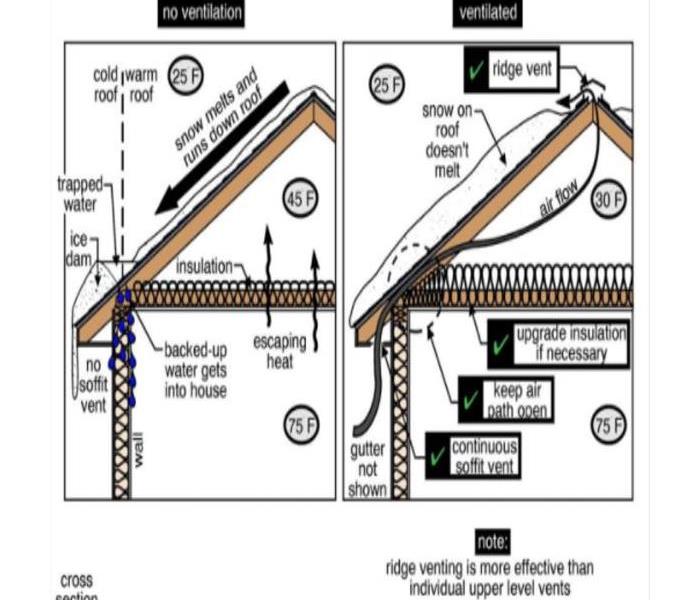
What is an ice dam?An ice dam is a ridge of ice that forms at the edge of a roof and prevents melting snow (water) from draining off the roof. The water that backs up behind the dam can leak into a home and cause damage to walls, ceilings, insulation, and other areas. The image included in this blog entry shows a cross section of a home with an ice dam.
What causes ice dams?There is a complex interaction among the amount of heat loss from a house, snow cover, and outside temperatures that leads to ice dam formation. For ice dams to form there must be snow on the roof, and, at the same time, higher portions of the roof's outside surface must be above 32°F while lower surfaces are below 32°F. For a portion of the roof to be below 32°F, outside temperatures must also be below 32°F. When we say temperatures above or below 32°F, we are talking about average temperature over sustained periods of time.
The snow on a roof surface that is above 32°F will melt. As water flows down the roof it reaches the portion of the roof that is below 32°F and freezes. Voila! - an ice dam.
The dam grows as it is fed by the melting snow above it, but it will limit itself to the portions of the roof that are on the average below 32°F. So the water above backs up behind the ice dam and remains a liquid. This water finds cracks and openings in the exterior roof covering and flows into the attic space. From the attic it could flow into exterior walls or through the ceiling insulation and stain the ceiling finish.
Remember: Nonuniform roof surface temperatures lead to ice dams.
National Preparedness Month
9/14/2017 (Permalink)
September is National Preparedness Month. The best way to survive a disaster is to have a plan in place prior to such an event happening. These past couples of weeks have put on display the importance of knowing what to do should disaster strike. Fires, floods, earthquakes, tornadoes, hurricanes and blizzards all can put you and your family at risk. Nowadays we take for granted the ability to communicate with our loved ones at anytime and from anywhere. As we have learned, communication channels can be brought down. If disaster strikes would you be able to communicate with all the members of your household? More importantly would they know how to reach each other and where to meet up?
The following is an outline, published by the Department of Homeland Security on their website, which can be used to guide you and your family as you created your own plan.
Planning starts with three easy steps:
- COLLECT. Create a paper copy of the contact information for your family and other important people/offices, such as medical facilities, doctors, schools, or service providers.
- SHARE. Make sure everyone carries a copy in his or her backpack, purse, or wallet. If you complete your Family Emergency Communication Plan online at ready.gov/make-a-plan, you can print it onto a wallet-sized card. You should also post a copy in a central location in your home, such as your refrigerator or family bulletin board.
- PRACTICE. Have regular household meetings to review and practice your plan.
To view the complete outline visit our blog, SERVPROnorwoodwestroxbury.blogspot.com
National Preparedness Month
9/14/2017 (Permalink)
September is National Preparedness Month. The best way to survive a disaster is to have a plan in place prior to such an event happening. These past couples of weeks have put on display the importance of knowing what to do should disaster strike. Fires, floods, earthquakes, tornadoes, hurricanes and blizzards all can put you and your family at risk. Nowadays we take for granted the ability to communicate with our loved ones at anytime and from anywhere. As we have learned, communication channels can be brought down. If disaster strikes would you be able to communicate with all the members of your household? More importantly would they know how to reach each other and where to meet up?
The following is an outline, published by the Department of Homeland Security on their website, which can be used to guide you and your family as you created your own plan.
Planning starts with three easy steps:
- COLLECT. Create a paper copy of the contact information for your family and other important people/offices, such as medical facilities, doctors, schools, or service providers.
- SHARE. Make sure everyone carries a copy in his or her backpack, purse, or wallet. If you complete your Family Emergency Communication Plan online at ready.gov/make-a-plan, you can print it onto a wallet-sized card. You should also post a copy in a central location in your home, such as your refrigerator or family bulletin board.
- PRACTICE. Have regular household meetings to review and practice your plan.
To view the complete outline visit our blog, SERVPROnorwoodwestroxbury.blogspot.com
 When storms strike, you can rely on us to help you recover and restore your property with professionalism and care.
When storms strike, you can rely on us to help you recover and restore your property with professionalism and care.





 24/7 Emergency Service
24/7 Emergency Service


























